
Jean-Baptist Lelarge III, side chair, Paris, ca. 1780. Beech; paint. H. 35 3/8", W. 18 1/8", D. 16 1/2". (Courtesy, Mount Vernon Ladies’ Association; photo, Gavin Ashworth.)

Dessert service, Niderviller, France, ca. 1782. Porcelain (hard-paste). (Courtesy, Mount Vernon Ladies’ Association; photo, Gavin Ashworth.)

Adolf Ullrik Wertmüller (1751–1811), George Washington, United States, 1795. Oil on canvas. 25 1/2" x 20 13/16". (Courtesy, Nationalmuseum, Stockholm, Sweden; photo, Nationalmuseum, CC BY-SA.)
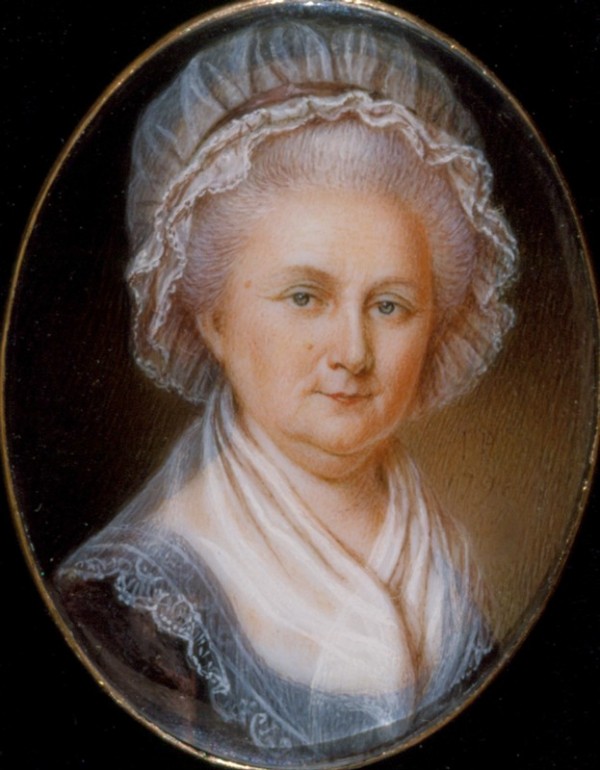
James Peale (1749–1831), portrait miniature of Martha Washington, United States, 1796. Watercolor on ivory. H. 1 5/8", W. 1 1/4". (Courtesy, Mount Vernon Ladies’ Association; photo, Paul Kennedy.)
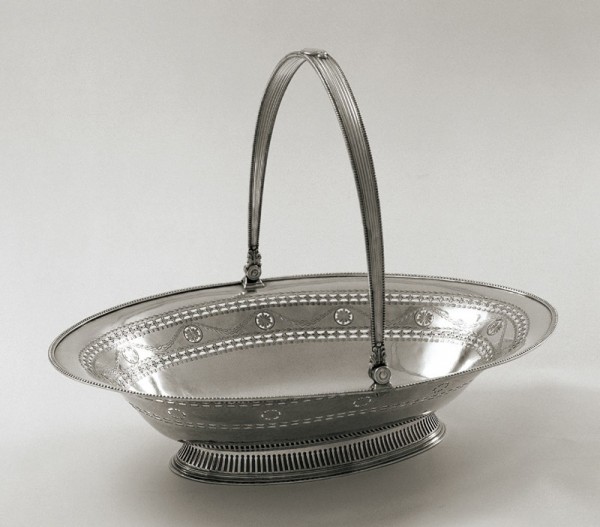
Bread basket, England or France, ca. 1783–1784. Sliver-plated copper. H. 11 1/2", W. 14 5/8". (Courtesy, Mount Vernon Ladies’ Association; photo, Gavin Ashworth.)

Wine coaster, England or France, ca. 1783–1784. Silver-plated copper, wood, ivory. H. 1 3/8", Diam. 5". (Courtesy, Mount Vernon Ladies’ Association; photo, Mark Finkenstaedt.)

Grand Salon from the Hôtel de Tessé, by Nicolas Huyot; carved by Pierre Fixon and (or) his son Louis-Pierre Fixon, Paris, ca. 1768–1772. (Courtesy, Metropolitan Museum of Art, gift of Mrs. Herbert N. Straus, 1942, acc.42.203.1.)
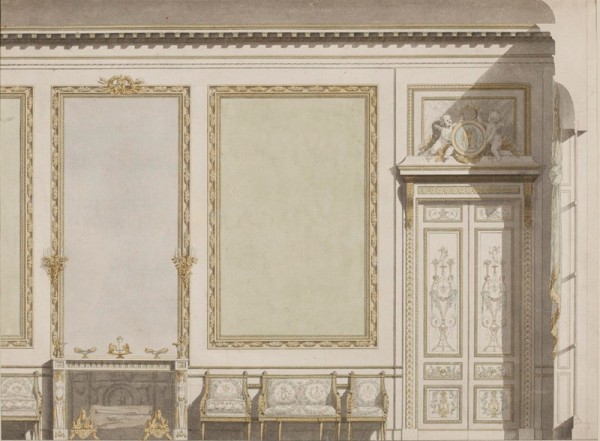
François-Joseph Bélanger, elevation of a wall in the salon of the duchesse de Mazarin, Paris, ca. 1780. Pen, ink, and watercolor on paper. 16 5/16" x 10 7/8". (Copyright, Victoria and Albert Museum, London.)
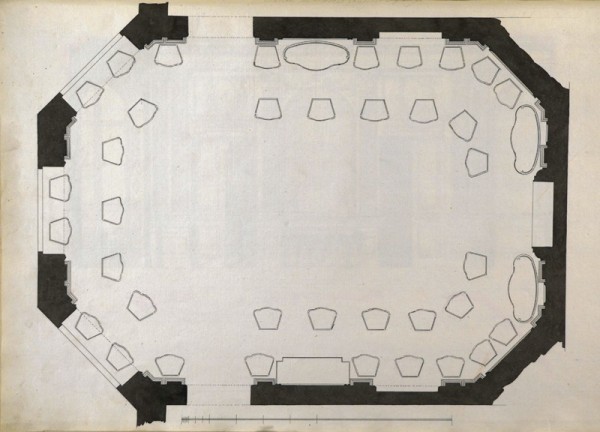
Erik Palmstedt, floor plan of the Hôtel du Châtelet, Paris, 1778–1780. Pen and ink on paper, 20 1/4" x 13 3/4". (Courtesy, Kungliga Akademien för de fria konsterna/Royal Academy of Fine Arts, Stockholm.) This plan shows the two-row circular configuration of seating with sieges meublants on the outside and sieges courants on the inside.
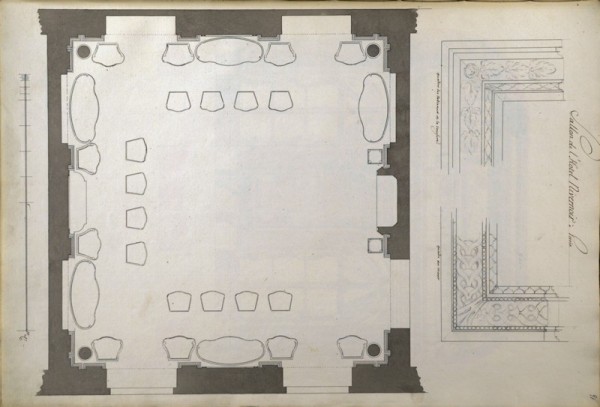
Erik Palmstedt, floor plan of the Hôtel du Nivernai, Paris, 1778–1780. Pen and ink on paper, 10 1/16" x 14 3/16". (Courtesy, Kungliga Akademien för de fria konsterna/Royal Academy of Fine Arts, Stockholm.) This plan shows the U-shaped grouping of side chairs in the center and the larger armchairs and sofas along the perimeter.
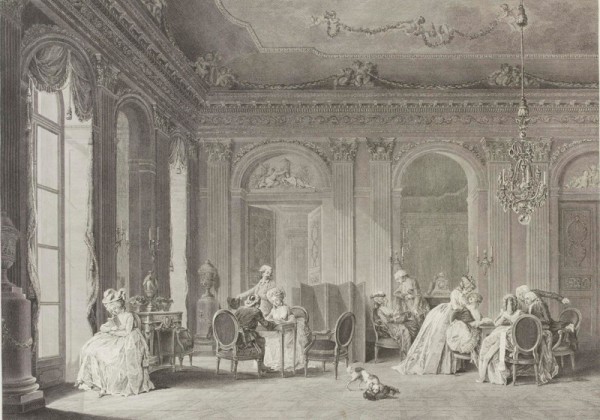
François Dequevauviller, after Niklas Lafrensen II, L’assemblé au salon (Gathering in a Salon), Paris, 1783–1784. Engraving and etching. 15 7/8" x 19 3/4". (Copyright, Victoria and Albert Museum.) The chairs have been arranged in small, informal groups for a variety of activities.
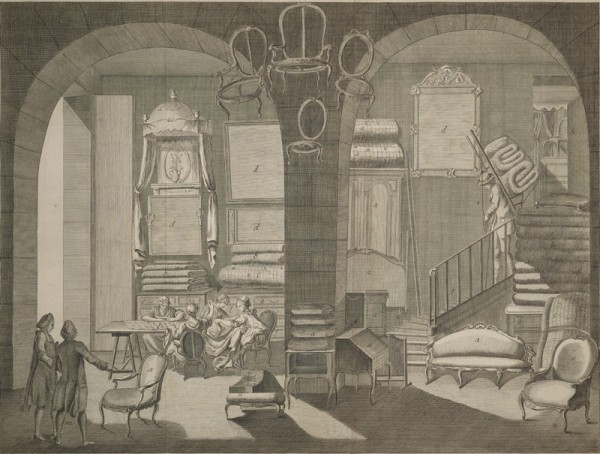
Robert Bénard, after Radel, Tapissier. Intérieur d’une boutique et differens ouvrages, plate 1, Encyclopédie, planches, sur les sciences, les arts libéraux, et les arts méchaniques, avec leur explication, vol. 9, edited by Denis Diderot et al. (Paris: Chez Briasson, 1762-1772). Engraving. 18 45/64" x 13 31/32". (Courtesy, Kislak Center for Special Collections, Rare Books and Manuscripts, University of Pennsylvania.)
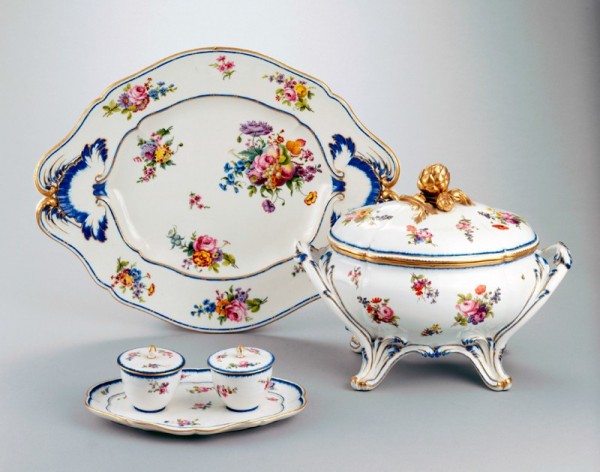
Soup tureen and stand and preserves stand, Royal Porcelain Manufactory of Sèvres, France, 1782. Porcelain. Tureen, H. 13"; Stand, H. 17 3/4"; Preserves stand, H. 3 3/16". (Courtesy, White House Historical Association © 2000.) John and Abigail Adams probably acquired this china service during their time in France while John Adams served as the minister to France between 1784 and 1785.
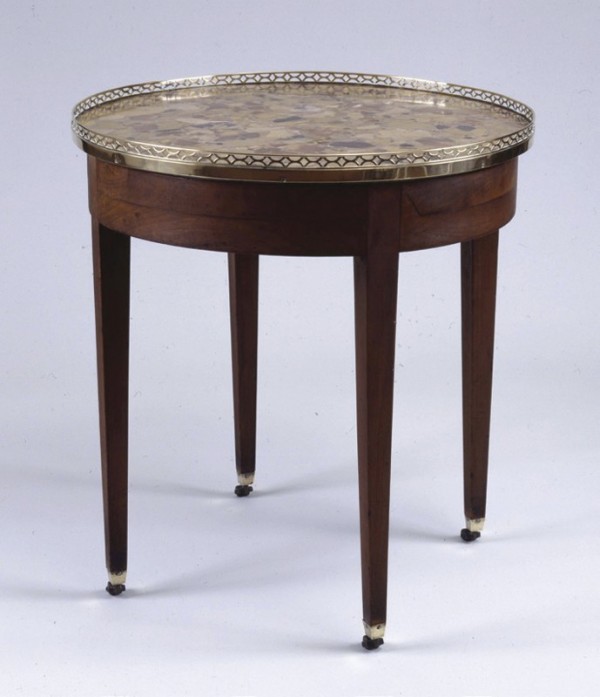
Table, France, ca. 1785. Cherry; Brescia marble, brass. H. 28 1/16", W. 25 5/8". (Copyright, Thomas Jefferson Foundation, Monticello.) While residing in Paris, Thomas Jefferson commissioned several pieces of furniture, including this table a trois fin. Jefferson likely appreciated the table’s versatility. It has a removable circular tabletop, finished in leather and wool on opposite sides, that can be placed on top of the marble to expand the table’s functions: the marble surface might thus be used to serve drinks, the leather for writing, and the wool for playing games.

Side chair, France, ca. 1780–1790. Beech. H. 37 1/2", W. 17", D. 16". (Courtesy, John Jay Homestead State Historic Site, Katonah, New York, New York State Office of Parks, Recreation and Historic Preservation; photo, Gavin Ashworth.) In the fall of 1783, Parisians were captivated by the recent invention of the hot-air balloon. Sarah Livingston Jay witnessed several ascents, including the first hydrogen-powered balloon flight by Jacques Charles and Nicolas Robert. Many French craftsmen translated the popular balloon shape into furniture, jewels, and clocks. The Jays brought two such souvenir chairs back to the United States upon their return in 1784.
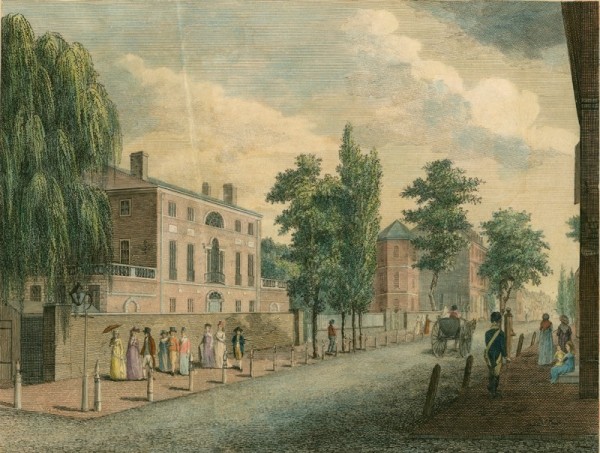
William Birch and Son, “View in Third Street, from Spruce Street, Philadelphia,” Philadelphia, 1800. Hand colored engraving on paper, 13" x 16". (Courtesy, Library Company of Philadelphia.) This view shows the William Bingham Mansion.
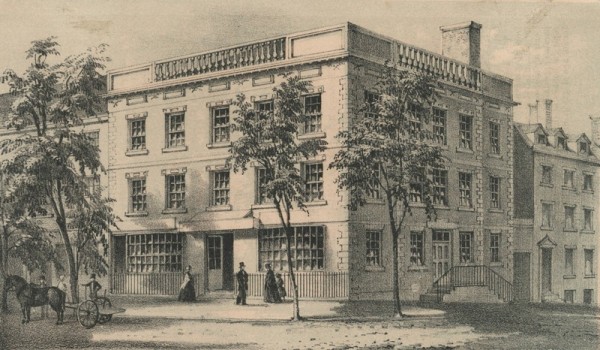
G. Hayward, “No. 3 Cherry Street, First Presidential Residence,” New York, 1853. Lithograph published in Valentine’s Manual [Manual of the Corporation of the City of New York, edited by D. T. Valentine]. (Courtesy, New-York Historical Society.)
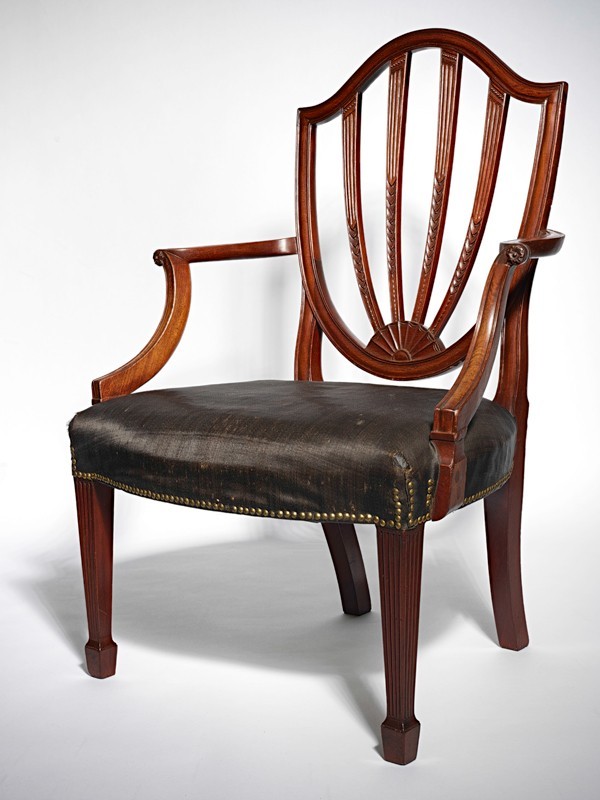
Armchair (one of a pair), attributed to Thomas Burling, New York City, ca. 1790. Mahogany with oak; haircloth. H. 40", W. 28", D. 17". (Courtesy, Division of Cultural and Community Life, National Museum of American History, Smithsonian Institution.)
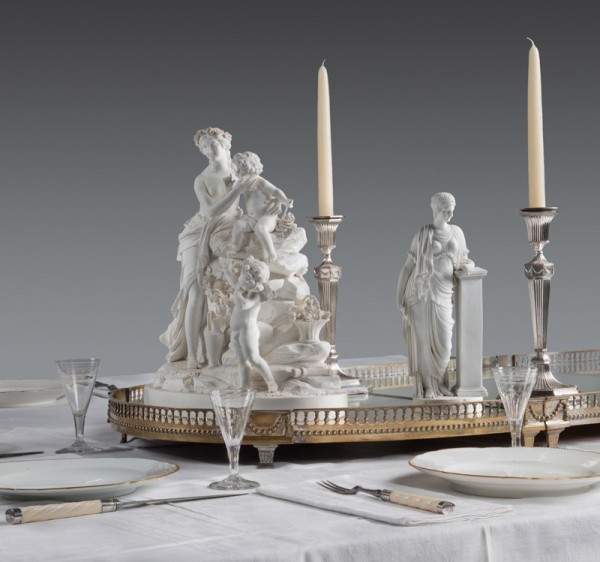
Presidential table wares, including the plateau, figural group of Venus and cupids and La Peinture, and Sèvres dinner service. (Courtesy, Mount Vernon Ladies’ Association; photo, Gavin Ashworth.)
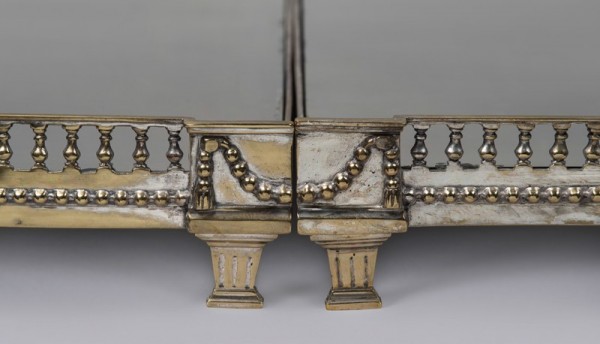
Plateau, France, ca. 1789. Silvered brass, mirrored glass, unidentified wood. H. 2 7/8", W. 17 3/8", L. 24". (Courtesy, Mount Vernon Ladies’ Association; photo, Gavin Ashworth.)

Figural group of Venus and cupids, Duc d’Angoulême’s porcelain factory, France, ca. 1790. Biscuit porcelain (hard-paste). H. 15 1/4", W. 12 7/8". (Courtesy, Mount Vernon Ladies’ Association; photo, Gavin Ashworth.)

La Peinture, Duc d’Angoulême’s porcelain factory, France, ca. 1790. Biscuit porcelain (hard-paste). H. 11 1/4", W. 5", D. 3 1/2". (Courtesy, Stephen L. Zabriskie; photo, Gavin Ashworth.

Charles Burton, “Bunker’s Mansion House, Broadway, New York City: Study for Plate 5A of ‘Bourne’s Views of New York,’” (39–41 Broadway), New York, ca. 1831. Brown ink and wash, gray wash, and graphite on paper. H. 2 5/8", W. 3 1/2". (Courtesy, New-York Historical Society, bequest of Stephen Whitney Phoenix, 1881.10.)
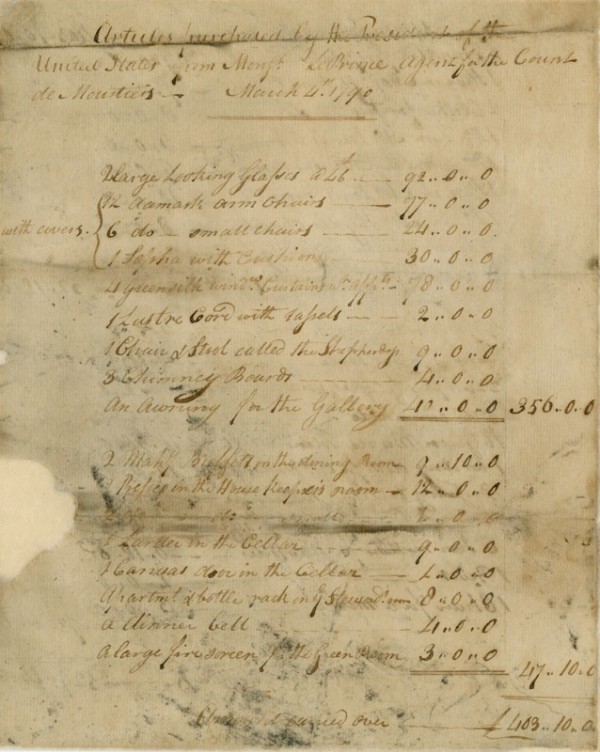
“Articles purchased by the President of the United States from Mons. Le Prince agent for the Count de Moustiers, March 4, 1790.” (Courtesy, Mount Vernon Ladies’ Association.)
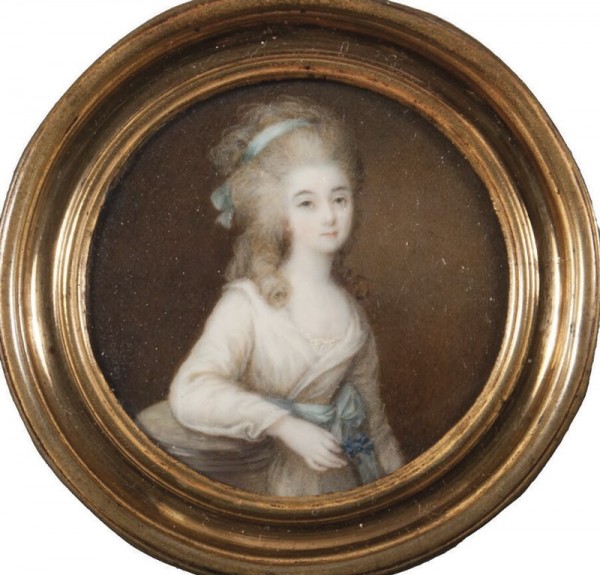
Ignazio Pio Vittoriano Campana, Marquise Jean-François-René-Almaire de Bréhan (Anne-Flore Millet), 1777. Watercolor on ivory. H. 2 11/16". (Courtesy, Nationalmuseum, Stockholm, Sweden; photo, Nationalmuseum, CC BY-SA.)
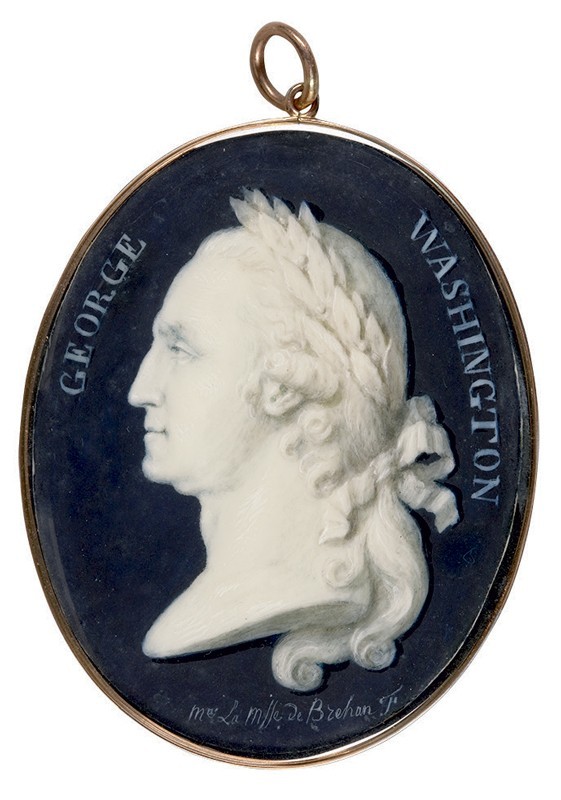
Marquise Jean-Françoise-René-Almaire de Bréhan (Anne-Flore Millet), George Washington, France, 1789. Watercolor on ivory. H. 2 3/4". (Courtesy, Yale University Art Gallery.) Madame de Bréhan was an accomplished pastelist and noted for the artistic decorations she created and displayed during lavish events at the minister’s residence. She made two miniatures of George Washington: the first shortly after her visit to Mount Vernon in the spring of 1788; and this one after her return to Paris in 1789.
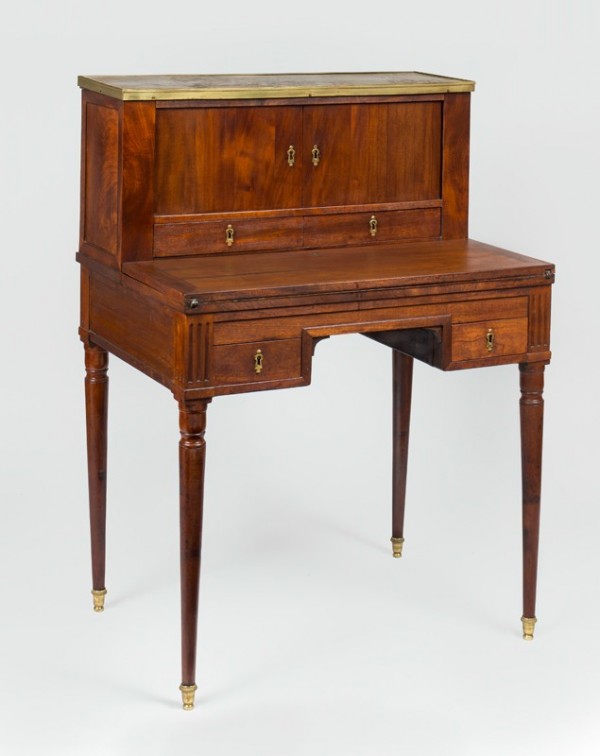
Victor-Jean-Gabriel Chavigneau, lady’s writing table, France, ca. 1787–1789. Mahogany and mahogany veneer with white oak; marble, brass, silvered brass, leather, gold leaf. H. 41 1/2", W. 28 1/4", D. 19". (Courtesy, Mount Vernon Ladies’ Association; photo, Gavin Ashworth.)
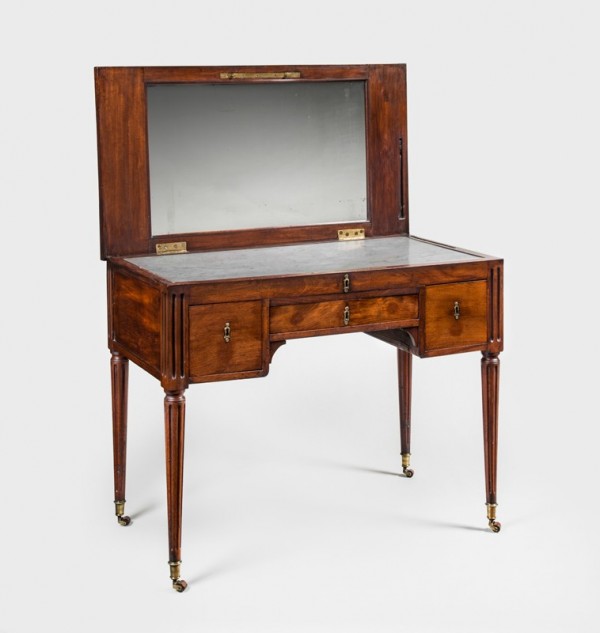
Dressing table, France, ca. 1760–1780. Mahogany with fir; marble, glass. H. 29", W. 37 5/8", D. 21". (Courtesy, Mount Vernon Ladies’ Association; photo, Gavin Ashworth.)

Bidet, France, ca. 1790. Mahogany; leather, brass. H. 15 1/2", W. 18 1/4", D. 8 7/8". (Courtesy, Joseph James Ryan; photo, Gavin Ashworth.)

Dinner service, Sèvres factory, France, ca. 1780. Porcelain (hard-paste). (Courtesy, Mount Vernon Ladies’ Association; photo, Gavin Ashworth.)

Abraham Godwin, label of Thomas Burling, New York, ca. 1786–1793. Engraving on paper. Dimensions not recorded. (Courtesy, Collection of the Museum of Early Southern Decorative Arts, Old Salem Museum and Gardens, Winston-Salem, North Carolina.)
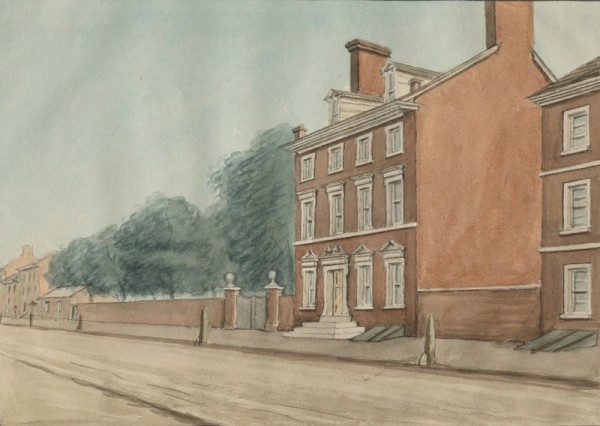
W. L. Breton, “Residence of Washington in High Street, Philadelphia,” Philadelphia, ca. 1828-1830. Watercolor on paper. 9 13/16" x 7 1/2". (Courtesy, Historical Society of Pennsylvania.)
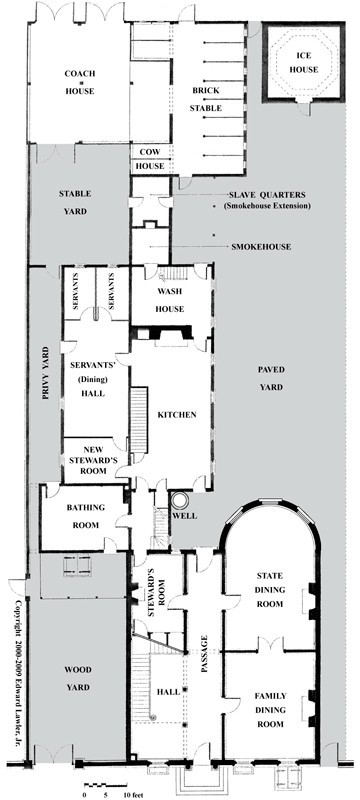
Conjectural floor plan (ground floor) of the President’s House in Philadelphia. (Courtesy, Edward Lawler Jr. © 2001-2019. All rights reserved.) The bottom is north.

Conjectural floor plan (second floor) of the President’s House in Philadelphia. (Courtesy, Edward Lawler Jr. © 2001-2019. All rights reserved.) The bottom is north.
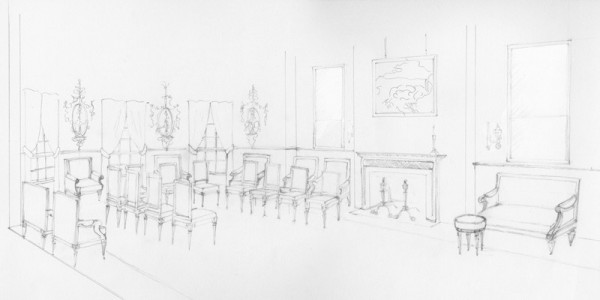
Conceptual sketch of the Green Drawing Room, President’s House, 190 High Street, Philadelphia. (Artwork by Wynne Patterson.) This is a visual interpretation that relies on such evidence as a fire insurance survey from 1773, Edward Lawler Jr.’s conjectural reconstruction of the floor plans, Washington’s inventory of the drawing room in 1797, personal correspondence of the president and his aides, as well as extant furnishings and architectural trimmings.
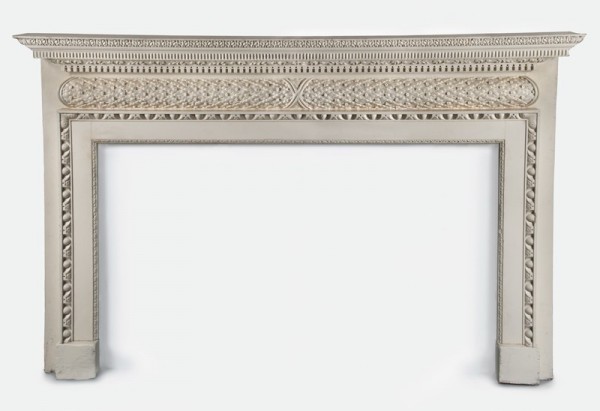
Mantelpiece, Philadelphia, ca. 1781. Wood; paint. H. 56 1/2", W. 79 1/2", D. 8 1/2". (Courtesy, Philadelphia History Museum at the Atwater Kent, Historical Society of Pennsylvania Collection; photo, Gavin Ashworth.) This mantelpiece was salvaged from the yellow drawing room in the President’s House prior to the building’s demolition in 1832, and the pulvinated frieze of banded foliage may represent the style of the woodwork on the mantel wall and above the doors in the green drawing room.
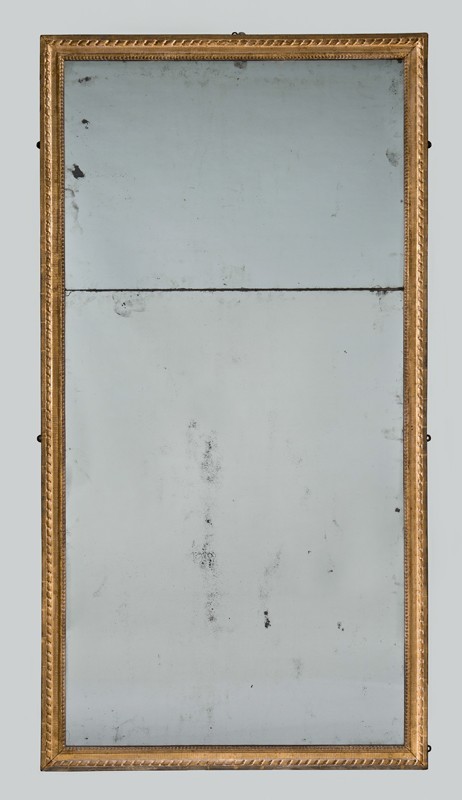
Looking glass, probably France, ca. 1788. Basswood; gesso, gold leaf, glass. H. 81 1/4", W. 43". (Courtesy, Mount Vernon Ladies’ Association; photo, Gavin Ashworth.)
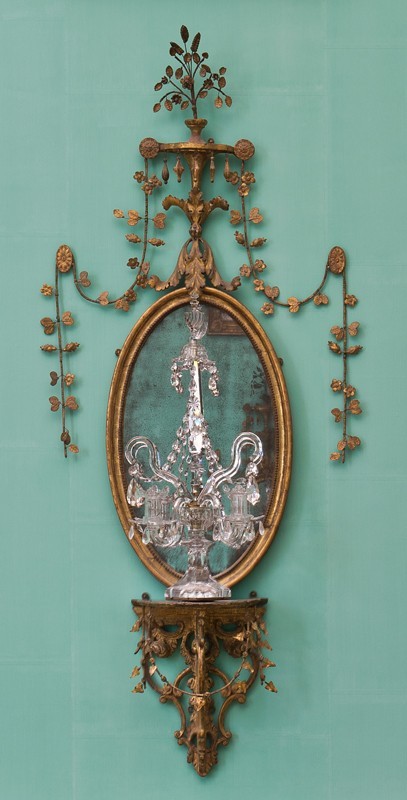
Looking glass, attributed to James Reynolds, Philadelphia, 1791–1797. Yellow poplar with Atlantic white cedar; gesso, gold leaf, glass. H. 50", W. 16 1/2". (Courtesy, Mount Vernon Ladies’ Association; photo, Gavin Ashworth.)

Wall bracket, attributed to James Reynolds, Philadelphia, ca. 1791. White pine; gesso, gold leaf, wire, iron. H. 15 3/4", W. 12 1/4", D. 9". (Courtesy, Mount Vernon Ladies’ Association; photo, Gavin Ashworth.)
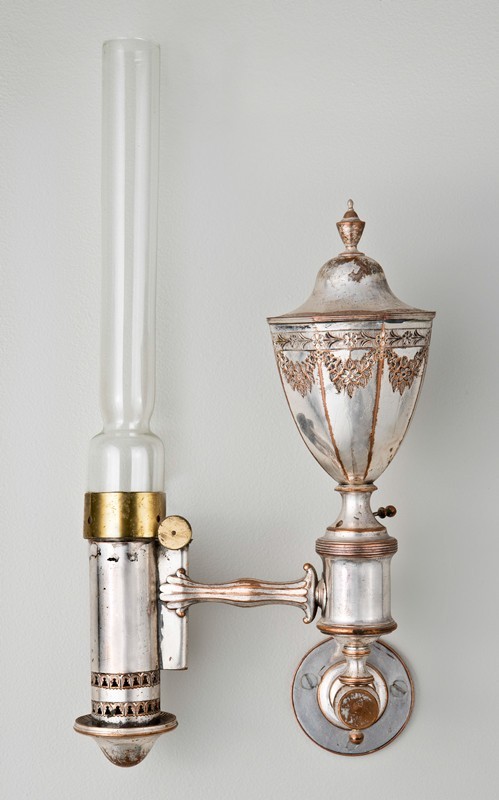
Argand wall lamp, probably England, ca. 1790–1797. Silver-plated copper, brass, tin, glass. H. 16 1/8", W. 7 3/4", D. 4". (Courtesy, Mount Vernon Ladies’ Association; photo, Gavin Ashworth.) This lamp was retailed by Joseph Anthony.
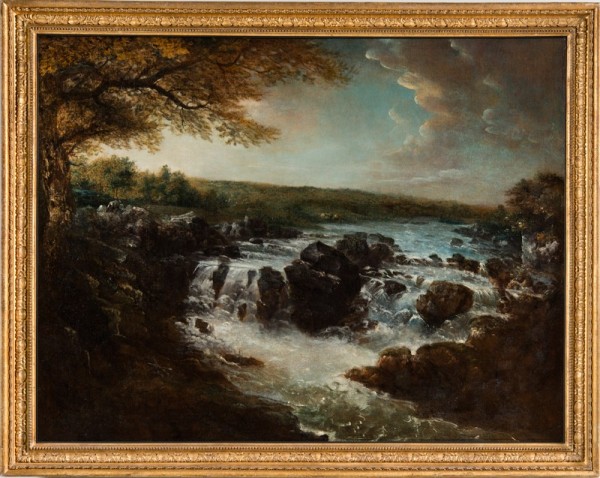
George Beck, The Great Falls of the Potomac, United States, 1797. Oil on canvas. 44" x 55 1/4". (Courtesy, Mount Vernon Ladies’ Association; photo, Gavin Ashworth.)

George Beck, The Passage of the Pato’k thro’ the blew mountain, at the confluence of that River with the Shan’h, United States, 1797. Oil on canvas. 39" x 49 5/8". (Courtesy, Mount Vernon Ladies’ Association; photo, Gavin Ashworth.)
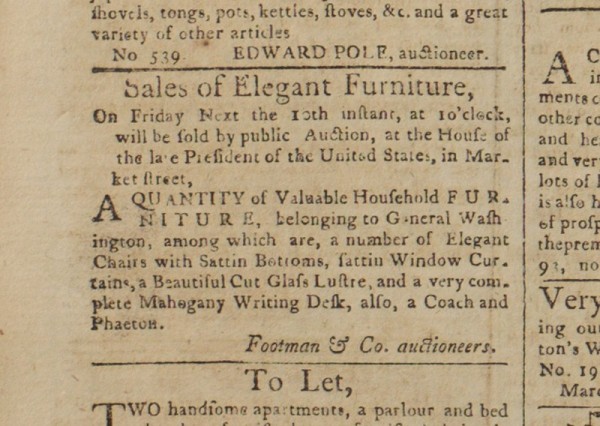
“Sales of Elegant Furniture,” advertisement in Claypoole’s American Daily Advertiser, Philadelphia, March 8, 1797. (Courtesy, Historical Society of Pennsylvania.)

New Room, Mount Vernon, Mount Vernon, Virginia. (Courtesy, Mount Vernon Ladies’ Association; photo, Gavin Ashworth.)
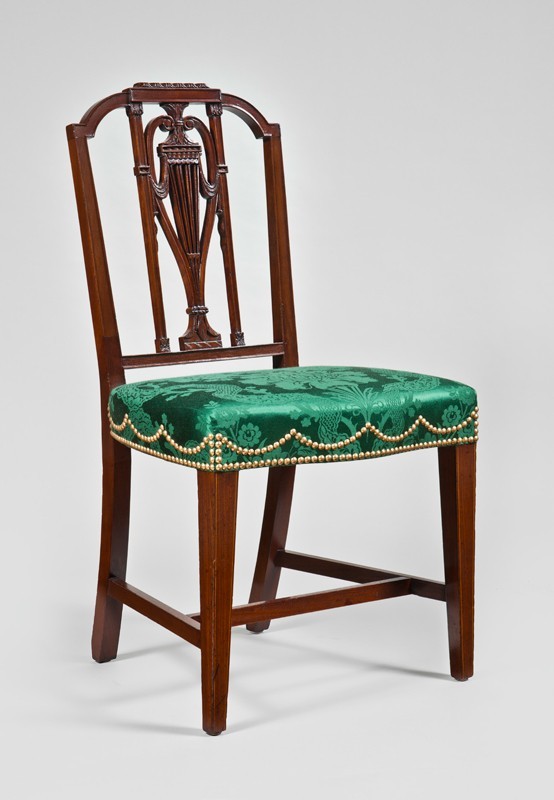
Side chair, attributed to John Aitken, Philadelphia, ca. 1797. Mahogany and light wood inlay with unidentified secondary wood. H. 37 7/16", W. 20 5/8", D. 18 3/4". (Courtesy, Mount Vernon Ladies’ Association; photo, Gavin Ashworth.)
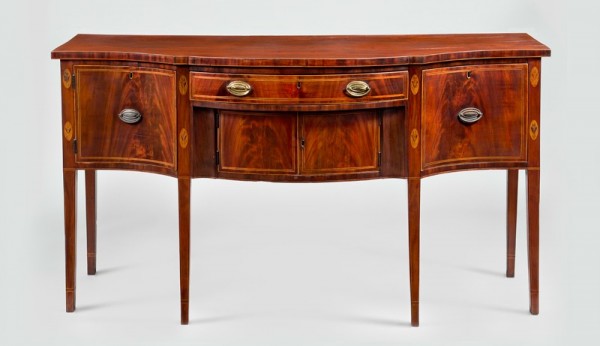
Sideboard, attributed to John Aitken, Philadelphia, ca. 1797. Mahogany, mahogany veneer, and light and dark wood inlays with white pine, tulip poplar, and unidentified softwood. H. 37 5/8", W. 71 7/8", D. 26 11/16". (Courtesy, Mount Vernon Ladies’ Association; photo, Gavin Ashworth.)

Bergère, attributed to Jean-Baptiste Lelarge, Paris, ca. 1780. Beech; paint, brass. H. 35 1/8", W. 25 1/2", D. 22 3/8". (Courtesy, Mount Vernon Ladies’ Association; photo, Gavin Ashworth.)
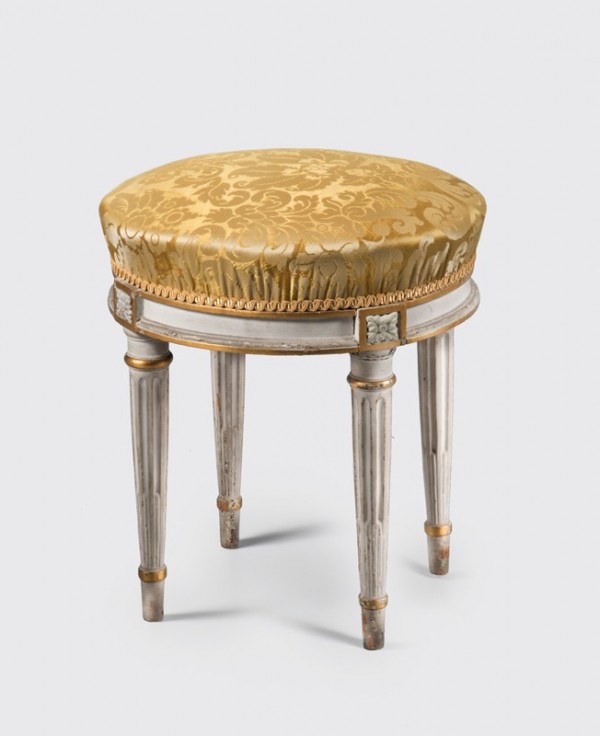
Footstool, attributed to Georges Bertault, Philadelphia, ca. 1793. Ash with sweet gum and beech; silk, flannel, haircloth. H. 18", D. 16 3/4". (Courtesy, Tudor Place Historic House and Garden; photo, Gavin Ashworth.)
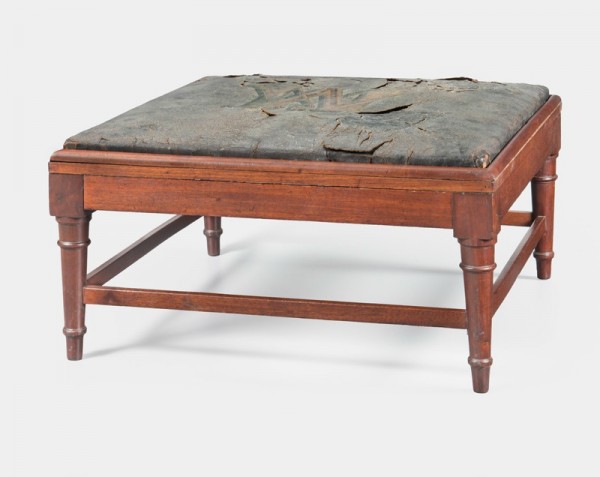
Footstool, attributed to Georges Bertault, United States, ca. 1788–1790. Mahogany, walnut, and pine; leather. H. 12", W. 23", D. 23". (Courtesy, Mount Vernon Ladies’ Association; photo, Gavin Ashworth.)

Armchair, France or United States, ca. 1790–1795. Unidentified woods; paint, silk. H. 34 1/2", W. 24", D. 21 1/2". (Courtesy, Museum of the American Revolution; photo, Gavin Ashworth.)

Detail showing the plaque on the armchair illustrated in fig. 50. (Photo, Gavin Ashworth.) The inscription reads: “Presented after Washington’s death, by the members of his Family to Gen. Sam Smith, after Gen. Smith’s death, purchased by Jno. B. Cannon, Baltimore, Md.”
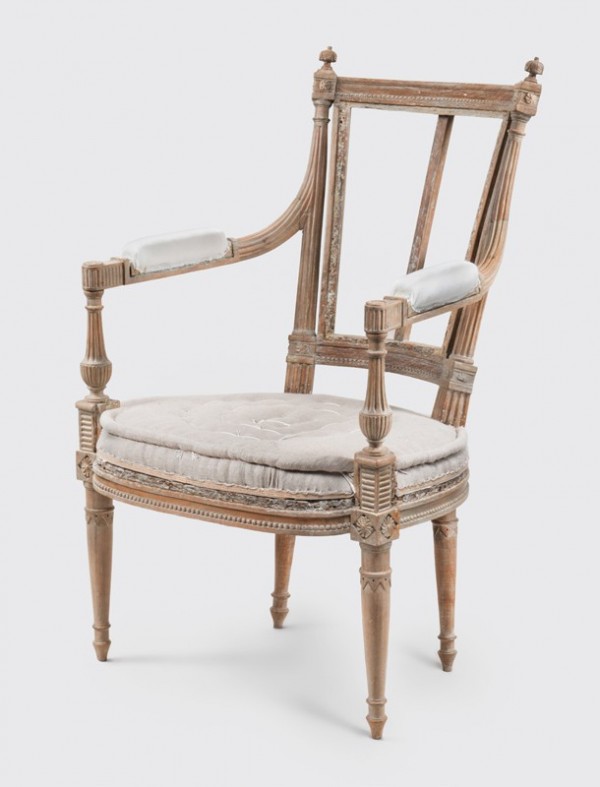
Armchair, possibly France, 1790–1800. Walnut. H. 38 1/2", W. 24", D. 18 3/4". (White House Collection, Courtesy, White House Historical Association © 2019; photo, Gavin Ashworth.)
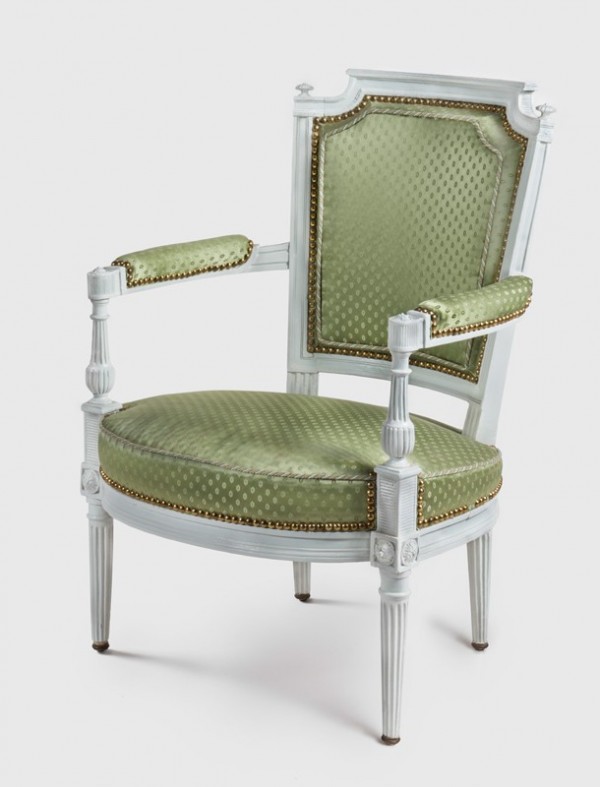
Armchair, France or United States, 1790–1795. Beech; paint. H. 31 3/4", W. 23 3/8", D. 20 1/4". (Courtesy, Mount Vernon Ladies’ Association; photo, Gavin Ashworth.)
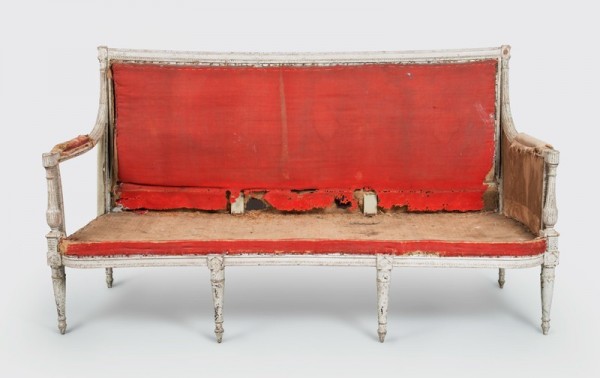
Sofa, probably France, ca. 1795–1800. European walnut; paint, silk. H. 39 7/8", W. 70", D. 23 1/2". (Private collection; photo, Gavin Ashworth.)

Details of the arm terminals of the chairs and sofa illustrated in (from left to right) figs. 50, 54, 53, 52. (Photos, Gavin Ashworth.)
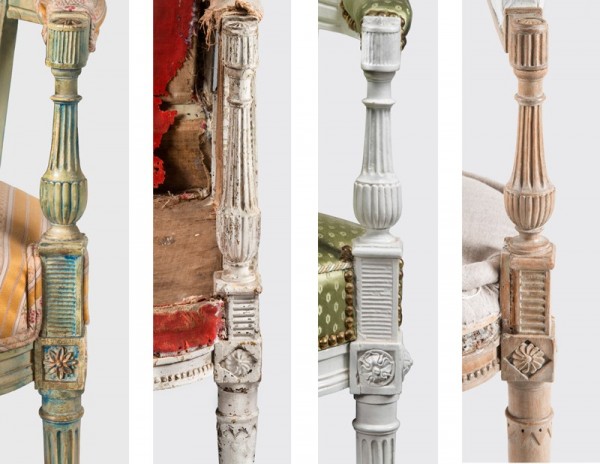
Details of the arm supports of the chairs and sofa illustrated in (from left to right) figs. 50, 54, 53, 52. (Photos, Gavin Ashworth.)
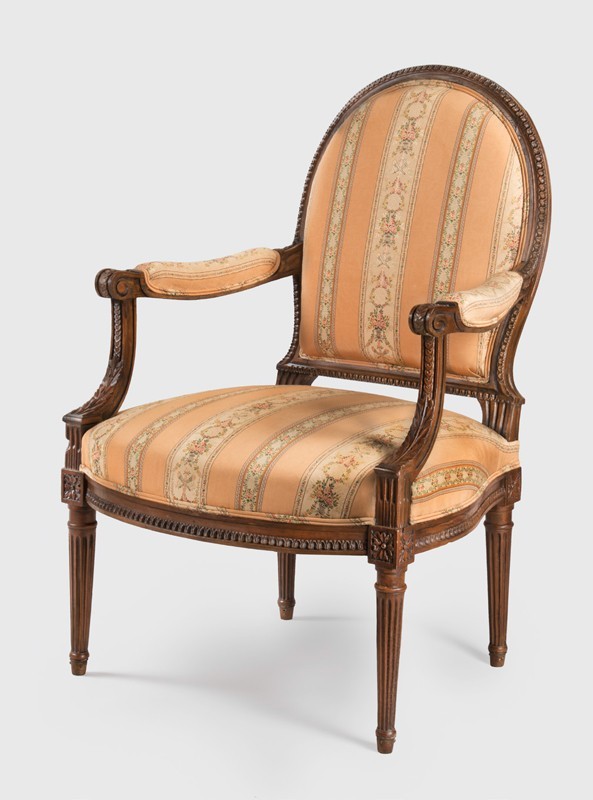
Armchair, probably France, 1785–1790. Beech; silk. H. 38 1/2", W. 24", D. 18 3/4". (Courtesy, Mount Vernon Ladies’ Association; photo, Gavin Ashworth.)

Armchair, possibly United States, ca. 1790–1810. Ash; paint, gold leaf, silk. H. 35 1/2", W. 21", D. 20". (Courtesy, Delaware Historical Society; photo, Gavin Ashworth.)

Armchair, France or United States, ca. 1785–1797. Beech; silk, linen, haircloth, paint, gold leaf. H. 34 1/4", W. 22 3/16", D. 22". (Courtesy, Connecticut Historical Society, lent by Mrs. Arnold G. Dana, 1983.57.0.)
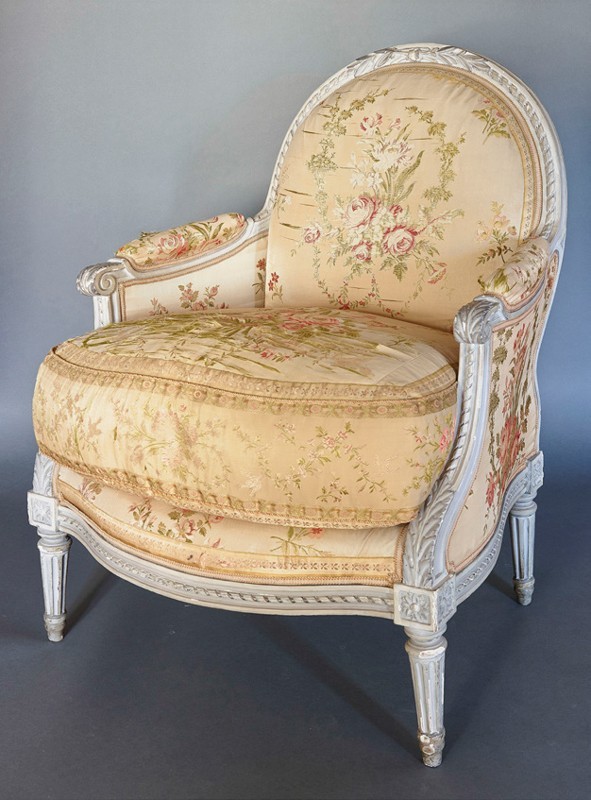
Jean-Baptiste Lelarge III, bergère, Paris, ca. 1780. Beech; paint, silk. H. 39 3/8", W. 28 1/2", D. 26 1/2". (Courtesy, Chateaux de Versailles et de Trianon, Versailles, France. Copyright, RMN-Grand-Palais/Art Resource, NY ; photo, Christophe Fouin.)

Jean-Baptiste Lelarge III, fauteuil, Paris, ca. 1780. Beech; paint, silk. H. 38 3/16", W. 26 7/32", D. 23 15/64". (Courtesy, Chateaux de Versailles et de Trianon, Versailles, France. Copyright, RMN-Grand-Palais/Art Resource, NY; photo, Christophe Fouin.)
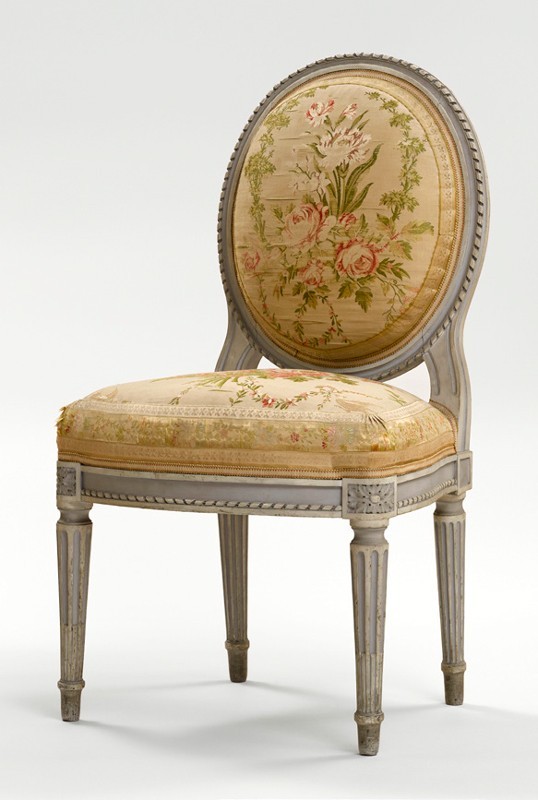
Chaise, Paris, ca. 1809. Beech ; paint, silk. H. 36 29/64", W. 19 11/16", D. 18 45/64". (Courtesy, Chateaux de Versailles et de Trianon, Versailles, France. Copyright, RMN-Grand-Palais/Art Resource, NY; photo, Franck Raux.)
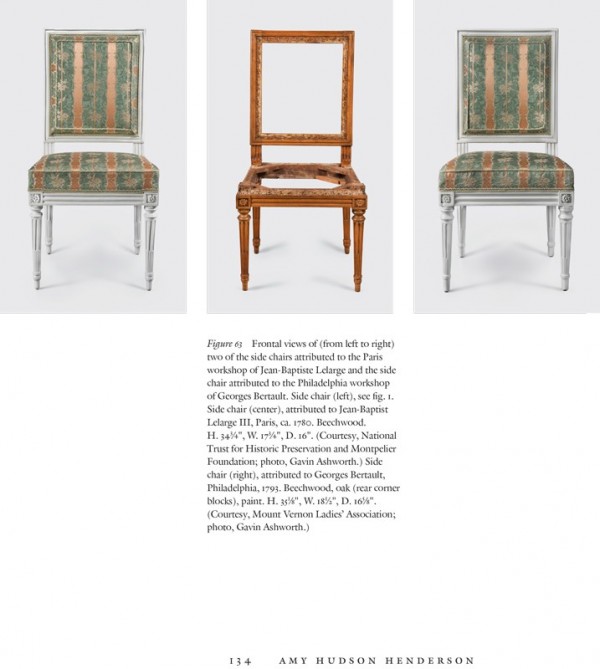
Frontal views of (from left to right) two of the side chairs attributed to the Paris workshop of Jean-Baptiste Lelarge and the side chair attributed to the Philadelphia workshop of Georges Bertault. Side chair (left), see fig. 1. Side chair (center), attributed to Jean‑Baptist Lelarge III, Paris, ca. 1780. Beechwood. H. 34 3/4", W. 17 3/4", D. 16". (Courtesy, National Trust for Historic Preservation and Montpelier Foundation; photo, Gavin Ashworth.) Side chair (right), attributed to Georges Bertault, Philadelphia, 1793. Beechwood, oak (rear corner blocks), paint. H. 35 1/8", W. 18 1/2", D. 16 5/8". (Courtesy, Mount Vernon Ladies’ Association; photo, Gavin Ashworth.)

Editorial, New York Journal, March 28, 1788. (Courtesy, Library of Congress; photo, author.)

Armchair, New York, ca. 1788. Mahogany. H. 36", W. 23 1/2", D. 20". (Courtesy, New-York Historical Society.)
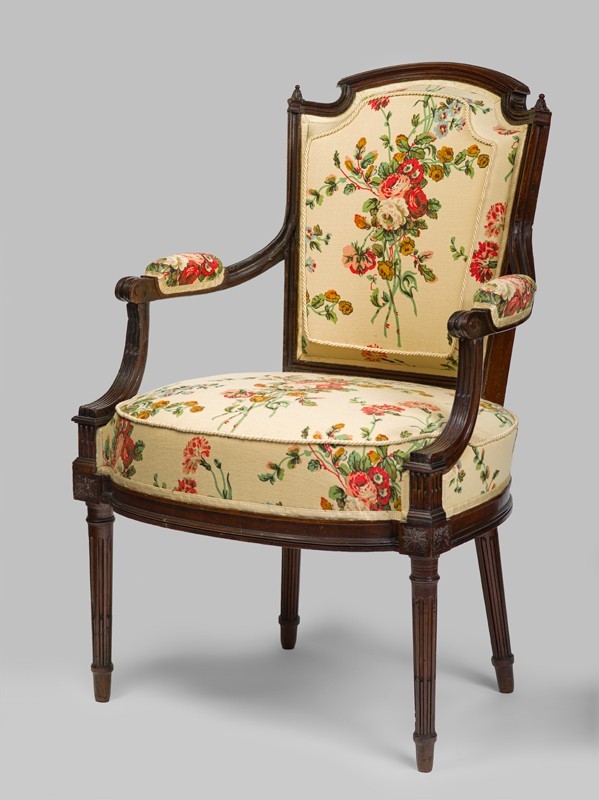
Armchair, attributed to Georges Bertault and Adam Hains, Philadelphia, 1793. Mahogany, ash. H. 35", W. 23", D. 19 3/4". (Courtesy, Longfellow House-Washington’s Headquarters, National Park Service; photo, Andrew Davis.)

Detail showing the stamp on the side illustrated on the far left in fig. 63.

Five of the six surviving pieces from George and Martha Washington’s Green Drawing Room suite.
Abigail Adams likely determined the fate and historical fortunes of the French furniture suite that once graced George and Martha Washington’s presidential drawing room when, as the incoming first lady, she declared to her husband in February 1797: “I want not a stick of it at the close of the term” (fig. 1). Resolved that Congress—and not she and John—should pay to refurnish the president’s residence after the Washingtons retired to Mount Vernon that spring, Abigail instructed her husband to turn down George Washington’s offer to purchase the fine French chairs and settee the Washingtons had assembled during George’s presidency. As John informed his wife, the president personally owned the furniture in the drawing room, besides many items throughout the house, and now “all the Glasses, ornaments, kitchen furniture, the best Chairs, settees, Plateaus &c.” had to be replaced. The Adamses, however, were determined to live modestly and within the allowance Congress provided for household furnishings and expenses—even if it meant, as John put it, they “shall be put to great difficulty to live and that in not one third the Style of Washington.” As a result, they declined to purchase the “Articles in the Green Drawing Room” proffered by Washington. The Adamses’ decision thus set in motion the first auction of presidential furniture and, ultimately, the widespread dispersal of what would become the famed—and elusive—drawing room suite.[1]
More than 200 years after the Adamses’ decision, historians continue to search for those auctioned chairs and settee in the French taste, as they unquestionably give insight into the Washingtons and their carefully considered furnishing choices. Just as pertinent, however, is what this famous suite reveals about the material and philosophical decisions many members of the founding generation faced when they set out collectively to build their new republic. In essence, the story of a few chairs brings attention to several key questions these men and women faced as they transitioned from a confederation to a more mature nation. For instance, would the leaders of this new nation follow the materials and manners of Britain and Europe, or would they embark on something entirely new? How would they define moderation and simplicity as well as extravagance and superfluity? And, how would these concepts impact the development of a cohesive national identity? Scholars seek to identify and authenticate the pieces in this drawing room suite because their journey from an upholsterer’s workshop in Paris to a workshop in New York (after being damaged in the Atlantic crossing), their service in the elevated salons of a French ambassador and then an American president, and finally their legacy as souvenirs after that 1797 auction, attest to—and visually document—the emerging and competing values that profoundly shaped Federal America.[2]
Today there is considerable confusion about what the Washingtons’ French furnishings looked like since there are multiple contenders that vary in style, materials, and provenance. New research into written records and the physical evidence of extant pieces now allows scholars to clarify several misattributions and to state with greater authority which of these pieces were once part of the set. According to historical records, the core of the suite comprised twelve armchairs, six side chairs, and a sofa—all upholstered in a green, flowered silk damask and made in Paris by Jean-Baptist Lelarge—and imported into the United States by then-French ambassador the cômte de Moustier. Washington purchased the suite in 1790 and three years later commissioned Georges Bertault, a French émigré upholsterer in Philadelphia, to make an additional six side chairs and two stools in a matching green silk. Ever since the twenty-four green chairs and a sofa were purportedly sold at auction in 1797, there has been tremendous interest in the pieces as relics of Washington, his presidency, and the style of his and Martha’s republican court. There has also been uncertainty as to which “relics” are authentic.[3]
This article relates a broad story about the Washingtons and how they came to be interested in, and have access to, a wide array of French decorative objects. The narrative explores how the Washingtons navigated the changing perceptions of what kinds of material display were appropriate, desirable, and even necessary, in a nascent republic; the role of American diplomats and tourists in introducing the French taste to their countrymen; the French craftsmen responsible for their suite of furniture and shopping practices in ancien régime Paris; and finally, what the green drawing room in the President’s House in Philadelphia looked like during the Washingtons’ tenure. By contextualizing the suite in terms of its style, function, and evolution in the salons of Paris, New York, and Philadelphia, we can analyze more deeply the cultural and political vision the Washingtons and their contemporaries shared for their country.
The story of the Washingtons and their consumption of French fashions should rightly begin at the close of the Revolution, when Americans were seeking ways to rebuild their communities and homes after seven long years of war. It was in the early 1780s when the Washingtons were introduced to the elegant manufactures of Paris and had their first taste of what the luxury capital of Europe had to offer. Through the friendships they formed with French officers serving in the war, they were exposed to French aristocratic manners. In 1782 Martha received a “Present of Elegant China” from a titled French officer, Adam-Philip, comte de Coustine, in appreciation for a dinner he attended at Mount Vernon (fig. 2). The tea and coffee service was likely a sampler set since each piece is enameled with a different combination of ribbons, swags, garlands, bands, and scrolls yet linked by the monogram “GW.” In one gesture, the comte de Coustine demonstrated his admiration for Gen. Washington and his family while simultaneously advertising the wares of the Niderviller porcelain factory, of which he was the principal owner. In return, the Washingtons joined a select community of Americans with access to the products of France. Equally important, they now had friends with knowledge of, and a taste for, such refined wares.[4]
The following year, as the war ended and Gen. Washington prepared to return to Mount Vernon and resume life as a private citizen, he initiated a plan to enhance the French porcelain service with a collection of new furniture, dinner china, and silver wares. Accordingly, he did what he had often done in the past: he sought out trusted friends and family members for advice on shopping. “There is another thing likewise which I wish to know,” he wrote to his nephew Bushrod Washington from his encampment at Rocky Hill, New Jersey,
& that is, whether French plate is fashionable & much used in genteel houses in France & England; and whether, as we have heard, the quantity in Philadelphia is large—of what pieces it consists, & whether among them, there are tea urns, Coffee pots, Tea pots, & the other equipage for a tea table, with a tea board, Candlesticks & waiters large & small, with the prices of each.
Bushrod was then studying law in Philadelphia and a frequent guest in the home of Samuel and Elizabeth Willing Powel, among the city’s more esteemed and wealthy citizens and dear friends to the Washingtons. One presumes Bushrod was happy to share his observations on what was fashionable in the homes of the city’s genteel families, many of whom he met through the Powels. Furthermore, he may have been able to visit shops along High Street to enquire about availability. Although there is no record of Bushrod’s response to his uncle, he likely wrote that yes, such items were fashionable, but no, not readily available in post-war Philadelphia, because the next letter Washington composed on the subject was to his French brother-in-arms, the marquis de Lafayette, requesting his assistance in procuring “everything proper for a tea table” in silver plate.[5]
Like so many of their colonial peers, the Washingtons (figs. 3, 4) were long used to Great Britain serving as their guide in all things cultural and material. In fact, prior to the war, few Americans had access (through either commercial or personal ties) to household goods that did not originate within the British Empire. All of this changed when the Confederation Congress dispatched diplomats to the courts of Europe; word of fashions on the Continent began to trickle home, first in personal correspondence and then when the goods themselves eventually arrived as gifts or prized possessions. Upon the signing of the Treaty of Paris in 1783, trade with foreign nations was legalized, and Americans eagerly turned to France to see what she had to offer in the domestic line. Indeed, post-war negotiations among the British, French, and Americans were barely over before Washington initiated his correspondence with Lafayette.[6]
Washington could not have selected a better friend than Lafayette to help him with his shopping, for the marquis had returned to France during the treaty negotiations with the view of being an unofficial American representative at the court of Louis XVI. Lafayette’s passion for the well-being of both countries led him to believe that a policy of open markets was in the best interests of both nations. In his view, this was the only viable way for America to rebuild its commerce and thus repay its debt to France. Ideally, the French would provide a market for America’s raw materials in exchange for manufactured goods, and if France acted quickly to open her markets, there was the added benefit of financially cutting off the British from her former colonies. Lafayette surely recognized that there could be no better way to show off the variety and beauty of French wares than by sending examples to the Washingtons at Mount Vernon.[7]
Washington knew his friend well and understood that he would be delighted to serve as a proxy shopper. Yet Washington still felt the need to justify the commission, assigning the following reasons for recruiting Lafayette as his delegate:
1st. then, because I do not incline to send to England (from whence formerly I had all my goods) for any thing I can get upon tolerable terms elsewhere.
2nd. Because I have no correspondence with an[y] Merchants or artisans in France.
3d. If I had, I might not be able to explain so well to them, as to you, my wants, who know our customs, taste & manner of living in America. and 4th Because I should rely much more upon your judgment and endeavors to prevent impositions upon me, both in the price & workmanship, than on those of a stranger.
It is hard to know which of the reasons was most important—breaking ties with England, getting the best price, or having a friend with good judgment to serve as a style guide—yet the last may well have been uppermost in Washington’s mind. At the start of the letter he also noted that “as I am not much of a connoisseur in, & trouble my head very little about these matters, you may add anything else of the like kind which may be thought useful & ornamental.” Washington was looking for guidance on what was fashionable and appropriate and evidently ready to put himself in the hands of the marquis for his first commission of French wares.[8]
The memorandum Washington included at the end of the letter documents an extensive order, and one wonders what role Martha played in the process, especially in light of Washington’s admission that he thought little upon these matters. “A List of Plated Ware to be Sent to General Washington, by the Marq.s de la Fayette,” with the following descriptions, could very well be imagined as Martha communicating with Lafayette’s wife, Adrienne, who likely assisted her husband with the shopping:
Everything proper for a tea-table, & these it is supposed may consist of the following Articles: A Large Tea salver, square or round as shall be most fashionable; to stand on the Tea table for the purpose of holding the Urn, teapot, Coffee pot, cream pot, China cups and saucers &ca.
A large Tea-Urn, or receptacle for the water which is to supply the tea pot, at the table. 2 large Tea pots, and stands for Ditto, 1 Coffee Pot and stand, 1 Cream Pot, 1 Boat or Tray, for the Tea spoons, 1 Tea-chest, such as usually appertains to tea or breakfast tables, the inner part of which, to have three departments, two for tea’s of different kinds, the other for Sugar. If any thing else should be judged necessary it may be added, although it is not enumerated.
Also, Two large Salvers, sufficient to hold twelve common wine glasses, each.
Two smaller size Do for 6 wine glasses, each.
Two Bread baskets, middle size.
A Sett of Casters, for holding, oil, Vinegar, Mustard &ca.
A Cross or Stand for the centre of the Dining table.
12 Salts, with glasses in them.
Eight Bottle sliders.
Six large Goblets, for Costers.
Twelve Candlesticks. Three pair of snuffers, and stands for them.And anything else which may be deemed necessary, in this way. If this kind of plated Ware will bear engraving, I should be glad to have my arms thereon, the size of which will, it is to be presumed be large or small in proportion to the piece on which it is engraved.
The marquis and marquise de Lafayette were pleased to help the Washingtons establish connections with Parisian silver merchants, and by the spring of 1784 the Lafayettes had done their best to fulfill the order. Surviving pieces include a pierced, oval bread basket with engraved leaves, wheelwork flowers, and swags, as well as a similarly decorated bottle slider, or coaster, both done in the delicate neoclassical style then taking over cosmopolitan Europe (figs. 5, 6). With these wares as exemplars, the Washingtons and Lafayettes began to ponder the many commercial advantages that could result from a strong Franco-American trade relationship.[9]
The Washingtons were hardly alone in turning to France for commercial and cultural opportunities. By the time the Treaty of Paris was ratified on September 3, 1783, an influential band of American diplomats, businessmen, and tourists had gathered in the French capital and were becoming acquainted with Paris and her material world first hand, an experience that would profoundly impact them and their country’s future. The list of Americans in Paris after the war is long and distinguished and includes such individuals as Benjamin Franklin, John and Sarah Livingston Jay, John and Abigail Adams and their children (John Quincy, Charles, and Nabby), Thomas Jefferson, William and Anne Willing Bingham, Alice DeLancey Izard, Gouverneur Morris, Abraham Swan, Henry Laurens, and Matthew and Anne Richardson Ridley. This expatriate group used diplomatic channels and ties with French officers and ministers, forged during the war, to gain entrée into the elite levels of French society. It was there—in the salons of French hostesses, along the paths of the Tuileries gardens, shopping in the Palais Royal, or visiting the theater—that they carefully observed French manners, hospitality, and style of living. It was also in Paris that these Americans began to form opinions about which (if any) French manners, and what material goods that supported politeness and sociability, would be best suited in a republic back home. A deeper look at their experience in Paris is therefore fundamental to the story of the Washingtons’ drawing room chairs. Collectively, the Lafayettes and expatriate friends helped the Washingtons develop an appreciation for French decorative arts as well as the art of polite sociability, which consequently influenced the appearance of, and protocols in, the president’s house.[10]
One could argue that among the many lessons Americans learned during their years in Paris was how to recognize the invisible ties among the French drawing room, worldly sociability, and the Enlightenment. As historian Antoine Lilti explores in his study of eighteenth-century Paris, behaviors in the drawing room had much to do with evolving notions of status, since men of noble birth could no longer rely on military valor or their membership in the nobility to solidify their high place in society. Rather, aristocratic prestige rested on being a l’homme du monde or “man of the world,” capable of demonstrating mastery of the cultural practices of polite society. In salons—the appartements de societé or the room in a Paris townhouse where hosts received guests—men and women could practice, perfect, and demonstrate their worldly sociability and lay claim to this prestige. Moreover, in contrast to the French royal court, salons were spaces in which individuals of varied backgrounds (aristocrats, men of letters, patrons of the arts and belle lettres, diplomats, members of government, financiers, and foreign visitors) could assemble and converse on a wide range of topics, all the while exhibiting wit, knowledge, and generosity to others. The salon was ultimately both a physical space and a society composed of men and women, based in private homes and often orchestrated by women, where individuals made (or lost) their reputations for gentility and civility.[11]
Tastefully decorated salons were integral to the demonstration of prestige and worldly hospitality; elegant furnishings not only signaled a host’s financial resources but also his or her commitment to what was known as l’art de vivre. Historian Joan DeJean has shown how this concept, the art of living, grew out of Greek Stoic philosophy and by the late eighteenth century could be linked directly to the decorative arts and manufactures of France. Drawing on related strands of Enlightenment thought, DeJean argues that when civilizations began to measure themselves by their degree of material, social, and cultural advance, then enhancements in architecture and household furnishings—such as improved seating furniture, more efficient lighting, or the convenience of indoor plumbing—were an indication of rational thought and a society’s ability to make continual progress. She sees the French as taking this idea one step further and states “it was only in a comfortable environment that individuals could use rational thinking (as opposed to religious faith) to transform their way of life.” The relationship then, among French furniture design, materials, and use at the end of the ancien régime is clear: the French style came to be synonymous not just with quality, beauty, and comfort but also with rational thinking and worldly sociability.[12]
Letters and journal entries by Abigail and Nabby Adams, John and Sarah Jay, Thomas Jefferson, and Gouverneur Morris all attest to the importance—and indeed brilliance—of this salon culture in 1780s Paris. As members of the diplomatic corps, they received their education in French manners in the afternoon salons and evening dinner parties of some of America’s greatest champions, including the marquis and marquise de Lafayette, the marquis and marquise de Chastellux, the duchesse de Mazarin, monsieur and madame Necker, madame de Genlis, madame de Ségur, madame de Helvetius, and madame de Tesse. In these elaborately decorated rooms, such as the grand salon from the Hôtel de Tesse (fig. 7), the Americans observed how to blend politics and politeness. They discovered which decorative furnishings lent support to their hosts’ efforts to create spaces of distinction and comfort, on the one hand, and how those furnishings were best arranged to facilitate rational conversation and entertainment on the other.[13]
Those lessons in decorating revealed the importance of creating visual and social harmony throughout the salon. By the 1780s the soft, curvaceous rococo style popular under Louis XV had given way to the geometry and motifs of the classical world favored by Louis XVI and his court. Well-appointed social spaces were filled with groups of objects that matched and were designed to work as a whole. New, specialized furniture forms—sofas, and chairs of varying shapes and sizes; tea, card, and pier tables; looking glasses and picture frames—coordinated with one another in materials, ornamentation, color, and texture as well as with the architectural fixtures, as demonstrated in the elevation by François-Joseph Bélanger for the salon of the duchesse de Mazarin illustrated in figure 8. Upholstery on chairs matched the window treatments. Both were likewise in accord with the color of the walls, whether they be covered with paint or wallpaper. Of all the objects in the salon, seating furniture was paramount. Chairs in this period were designed for a multitude of functions and consisted of two ranks: armchairs and side chairs. Large armchairs and sofas with flat backs (called sieges meublant) were placed along the walls around the room, while side chairs and lighter cabriolet armchairs (or sieges courants) were positioned either in a U or circular fashion to facilitate group conversation or in small clusters for games and private discourse (figs. 9-11). By some accounts, the formal etiquette of the French salon dictated that guests did not sit in the sieges meublant around the perimeter of the room but only in the sieges courants, and that the host and hostess reserved for themselves yet another form of armchair, the bergère, which was stationed on either side of the hearth, the place of honor. Symmetry, hierarchy, and harmony were the underlying principles in this French neoclassical decorating scheme.[14]
There was never any question in the minds of American diplomats that their world was quite different from the one they found in these aristocratic townhouses, yet they also realized that many aspects were adaptable and transferable. Subsequently, when they furnished their own homes in Paris to receive guests as part of their diplomatic obligations, they gave careful consideration to which furnishings they might bring home after their mission. It is interesting to note that among their first considerations was whether to buy French or British furnishings; both were available in 1780s Paris due to the Anglomania sweeping through many aristocratic households. Indeed, there was an equal degree of Francomania in London as British tourists, artists, and diplomats had likewise flocked to Paris at the close of the war intent on experiencing l’art de vivre and bringing home to England that quintessential French style.
Cross-pollination and exchange between the two countries was evident in everything from furniture, silks, and silver wares to garden design, scientific equipment, and porcelain. Nabby Adams, for instance, enjoyed two visits to the Paris home of the duc de Chartres—one of the more notable collectors of things English—and commented how “The Duke has built, finished, and furnished the house in the English style,” and she found the rooms “truly elegant.” And in London, cabinetmakers were heeding the advice of George Hepplewhite and Thomas Sheraton and making delicate, neoclassical drawing room chairs in the French taste: lightweight, upholstered in silk, and painted. The lesson learned from these examples was that sometimes the French, and sometimes the British, did things “better,” and it was the responsibility of savvy American consumers to decide which country’s manufactures suited their lifestyle.[15]
Gouverneur Morris nicely articulated the process Americans went through to find the right balance between the manufactures of France and England. In a 1792 letter to Thomas Pinckney, who was then serving as U.S. ambassador to Great Britain, Morris offered this advice:
In respect to Furniture there is no doubt but that rich and elegant Furniture can be had in this Town [Paris] for much less than London, but plain and neat Furniture can be had rather cheaper and a great deal better with you. The Stile of living in the two Countries is so different that I have found myself as it were oblig’d to lay out a great Deal of money in Furniture which I should hardly know what to do with in America, Whereas you can in London get Articles which will answer well to take with you.
Morris was not alone in his assessment. A popular travel journal aimed at advising German tourists similarly instructed readers intent on buying goods abroad: “English furniture is almost without exception solid and practical; French furniture is less solid, more contrived and more ostentatious.” And even the Frenchman and social observer Louis-Sébastien Mercier wrote: “England may seem to have more to offer in the way of peacefulness and the decent conduct of domestic life; but then, what prevents the Frenchmen from enjoying these blessings? They might be his if he would choose comfort and commodity rather than his present silly luxury, which kills true happiness and wastes energy and money.” Despite such a chorus of criticism, Paris remained the shopping destination for wealthy tourists, especially those making the Grand Tour, as it was the fashion center of Europe; and for every warning against buying French, there was an equally happy shopper who did so. The Baroness d’Obkirche, for instance, confided in her diary, “We did not know where to put all our purchases, which accumulate, one scarcely knows how, in a city like Paris.” So, shop in Paris these Americans did.[16]
Morris may have warned Pinckney away from investing in French goods, but he, like his predecessors Thomas Jefferson and Abigail Adams, was a seasoned shopper in Paris and knew what was available and at what price. They all spent time visiting the marchands merciers in the Palais Royal and along the rues Saint Honoré and Saint Martin, the heart of the high-end trade in new and used luxury goods, as well as the marchands de meubles (cabinetmakers), tapissier (upholsterers), and wallpaper and porcelain manufactories scattered throughout the city and surrounding villages (fig. 12). They visited shops for the social experience as well as for purchasing much needed household furnishings. Jefferson, it seems, furnished his Paris town-house top to bottom in the French style, while Abigail Adams just rented furniture and used her resources selectively to purchase table and bed linens, tea and dinner china, glass, and plate (fig. 13). Abigail complained about prices and that “Everything which will bear the name of elegant, is imported from England, and, if you will have it, you must pay for it, duties and all.” But Paris shops were renowned for both the quality and novelty of their wares. Indeed, there was a strong second-hand market that kept prices accessible for non-aristocrats. Ultimately, each of these Americans learned how to compare style, quality, cost, and suitability and to weigh their options with an eye both to their immediate needs in Paris and their future interests back home.[17]
Over the course of the next several years these American diplomats and travelers gradually made their way back to Massachusetts, New York, Pennsylvania, Virginia, and South Carolina, their minds filled with ideas and their trunks laden with goods. One cannot pass on the opportunity to reflect on the sheer amount of furnishings Jefferson shipped home in 1790: eighty-six crates filled with bedsteads, tables and chairs; paintings, looking glasses, wallpaper, and window curtains; silverware utensils and serving pieces, and a silver-plated plateau; dinner china, tea china, and decorative porcelain figurines for the table; clocks, watches, scientific instruments; and myriad other goods such as the Brescia marble table illustrated in figure 14. Philadelphians William and Anne Bingham, who completed a Grand Tour between 1783 and 1786, similarly returned with enough furnishings from Paris and London to outfit their 18,000-square foot mansion on South Third Street, then the largest townhouse in America. So notable was their taste that a visiting Frenchman remarked that the Binghams “displayed a luxury and a magnificence that could not be more French. He has built a very beautiful house that he is furnishing with the greatest elegance.” Whether on a small or grand scale, these diplomatic families shipped home enough French goods (and British-made goods in the French style) for themselves, their families, and their friends to make a statement about their newly acquired taste (fig. 15).[18]
Material souvenirs were only part of the imports, for these well-traveled Americans also returned with an acute awareness of French manners and the rituals of hospitality. Nabby Adams, who carefully chronicled the individuals she met while living in Paris, London, and New York—and was therefore well versed in behaviors at home and abroad—could appreciate a woman such as Anne Bingham for having mastered the art of conversation, or Sarah Jay in her pleasures of the French table. “Mrs. B. gains my love and admiration, more and more every time I see her,” Nabby confided in her journal:
she is possessed of more ease and politeness in her behavior than any person I have seen. She joins in every conversation in company; and when engaged herself in a conversation with you, she will, by joining directly in another chit chat with another party, convince you, that she is all attention to everyone.
The ability to converse freely, draw others into the conversation, and make everyone feel special was considered one of the highest accomplishments of the Parisian salonnière. Anne Bingham would show her friends in Philadelphia how it was done.[19]
In New York, Sarah Jay likewise introduced French customs. Nabby noted that when the Jays hosted a party for the diplomatic corps in the late 1780s, “the dinner was à la Française and exhibited more of the European taste than I expected to find.” These little insights on conversational style and how a table was set reveal the quiet way some of the wealthier, more influential families in the United States were adopting French customs. Before long, these were the families who would be shaping the political discourse during the Constitutional Convention and the creation of the federal government, and their time in Paris would be felt. Abigail Adams, who forever despaired at the costs tied to hospitality, never underestimated its worth. She saw clearly how all the lessons learned in the Paris salon—polite sociability, civility, and harmony—were put to use for diplomacy: “More is to be performed by way of negotiation, many times, at one of these entertainments, than at twenty serious conversations.” These Americans who ventured across the Atlantic to secure independence came home with the materials and manners of polite sociability that they would use—just as much as the trade agreements—to build and define their new republic.[20]
This interest in French manufactures and the French style remained steady in the years following the American Revolution. Many Americans saw the fine examples brought back by the diplomats, but they increasingly also had the opportunity to purchase French goods themselves. Importation statistics indicate that Great Britain continued to dominate the post-war American commercial market, but French furnishings did find their way into ever greater numbers of American homes. Few families, of course, spent time personally shopping in Paris and London or, as the Binghams had, turned their homes into showpieces of European elegance and style. Yet some did have friends abroad who served as proxy shoppers. Robert and Mary White Morris, Samuel and Elizabeth Powel, and James and Dolley Todd Madison relied variously on Gouverneur Morris, Sarah Jay, and James and Elizabeth Kortright Monroe to fulfill commissions, just as the Lafayettes had for the Washingtons. In this way Americans at home acquired French seating and case pieces (bedsteads, chairs, commodes, and tables); lighting devices (silver-plated candlesticks and Argand lamps); looking glasses; porcelain dinner and tea china; decorative plateaux with porcelain figurines, vases, and flowers; silk (damask and velvet for seating upholstery and plain silk for window treatments); and clocks.[21]
Finally, for those families with no international ties, there were always local shopkeepers and émigré craftsmen eager and willing to introduce them to the French taste. By 1787 cabinetmaker and carver William Long, recently arrived from London, advertised that he made “French Sophas in the modern taste” and had “Cabriole and French Chairs on reasonable terms.” In 1790 upholsterer Francis De L’Orme, lately from Paris, began boasting that he made furniture in “the most fashionable Taste, . . . all in the English or French style” and that he had an “assortment of Handsome Paper-Hangings from Paris.” Craftsmen’s advertisements suggest that by the 1780s, furniture and housewares in the United States were readily distinguishable by country of origin and that there was a French versus a British style on this side of the Atlantic Ocean. Consumers were therefore increasingly faced with a choice: how did they want their American homes to look? Further, what were they signaling if they invested in one style over another, or between things made in Europe versus in America? As the United States was moving closer to reorganizing itself as a more unified, federal body, what would it mean for its founders to embrace the French art de vivre?[22]
George Washington could very well have been mulling over such questions following the summer of 1787, when he resided in Philadelphia during the Constitutional Convention and was a daily witness to the fine French furnishings his friends the Binghams, Morrises, and Powels were displaying in their townhouses. With the aid of such companions as the comte de Coustine and the marquis de Lafayette, Washington had already been introduced to French manners and select examples of porcelain and silver table wares; but one can imagine the Binghams’ home was an entirely new experience for him (fig. 16). Polish statesman Julian Ursyn Niemcewicz left this account of visiting the Binghams’ grand house on South Third Street:
One mounts a staircase of white native marble. One enters an immense room with a sculptured fireplace, painted ceiling, magnificent rug, curtains, armchairs, sofas in Gobelins of France. The dinner is brought on by a French cook; the servants are in livery, the food served in silver dishes, the dessert on Sevres porcelain. The mistress of the house is tall, beautiful, perfectly dressed and has copied, one could not want for better, the tone and carriage of a European lady . . . . In a word, I thought myself in Europe. This house, as opulent as it is, would never be pointed out in the big cities of Europe, but here it attracts attention, criticism and envy; and woe for the country if it ceases to astonish, if it ceases to be pointed out.
Although Washington did not leave a similar account of his impressions (indeed, all he noted on his first visit in May 1787 was “Dined, and drank Tea at Mr. Binghams in great Splender”), he surely understood that the Binghams and their French taste represented an entirely new commitment to the cosmopolitan manners of Paris. Is it possible that the Binghams’ ostentation and obsession with Europe could have caused him to reconsider what place French-made things should have in the nascent republic?[23]
As the months ticked by and the delegates to the Constitutional Convention re-settled themselves in at home and waited for the states to ratify the constitution, Washington began to put into words his evolving thoughts about how much Americans should look to France for models of taste. Perhaps in anticipation of the coming election (in which he knew, whether he wanted to admit it openly or not, that he would be elected the first president), Washington spent time reflecting on American manners and the influence the new executive would have in shaping them. In response to a letter from his friend Annis Boudinot Stockton, in which she had congratulated him on the likely passage of the constitution, he returned the compliment by observing that while American women had been essential to the colonies in securing independence from Great Britain, they could now have an even more important role in the creation of the federal government. “I think the Ladies are in the number of the best Patriots America can boast,” he shared in August of 1788:
And now that I am speaking of your Sex, I will ask whether they are not capable of doing something towards introducing federal fashions and national manners? A good general government, without good morals and good habits, will not make us a happy People; and we shall deceive ourselves if we think it will. A good government will, unquestionably, tend to foster and confirm those qualities, on which public happiness must be engrafted. Is it not shameful that we should be the sport of European whims and caprices? Should we not blush to discourage our own industry and ingenuity; by purchasing foreign superfluities and adopting fantastic fashions, which are, at best, ill suited to our stage of Society?
Throughout his life Washington repeatedly embraced the principles of balance, and it would seem he thought the ladies of America were the best individuals to show the nation how to find balance in their manners and their homes. Within eight months Washington would rise to the presidency and need the aid of everyone—and especially women—to help him steer this infant nation down the right path, presumably away from “foreign superfluities” and “fantastic fashions” and toward republican simplicity.[24]
If Washington thought it would be easy to define republican simplicity as president, he would discover within days of arriving in New York City for his inauguration the inherent challenges in modeling such an ambiguous concept. This would prove especially difficult when he and Martha assumed the management of the first presidential household, a physical embodiment of the executive branch. The Washingtons may have wanted to encourage their countrywomen to furnish their homes with (and display on their bodies) American products that represented a national ingenuity and taste—and also spur on manufacturing and commerce—but in those early days of the federal government, the couple was unable to make that commitment. In 1783 buying French goods had helped Washington symbolically break with Great Britain, and six years later it would help him prove that the reconstituted United States was ready to be a player in the Atlantic world. He quickly realized that to secure his (and his country’s) place on the international stage, he would first have to demonstrate that he was an homme du monde, and he recognized that American manufactures were not quite ready for this task. So, with the help of America’s diplomatic families, the Washingtons would learn how to gain power and prestige by following the rules of civility and blending polite sociability with American politics. It is undoubtedly this recognition that led the Washingtons to buy the cômte de Moustier’s furnishings and chart a new path for republican simplicity, one that found inspiration in—but was never a slavish imitation of—French manners and materials.[25]
The story of the French furniture suite thus picks up again on the eve of Washington’s inauguration on April 30, 1789. In the frenzied days prior to the president-elect’s arrival in New York (by himself, as Martha remained in Mount Vernon for an additional two weeks to ready their household for the transition), Congress rented a house for the president at 3 Cherry Street and commissioned two local businessmen, Samuel Osgood and William Duer, to furnish the dwelling, top to bottom, in eight days (fig. 17). According to Osgood’s niece, Sarah Robinson, the gentlemen quickly recognized the monumental scope of this commission, so they “pitched on their wives” for help as the ladies were “likely to do it better.” Catherine Alexander Duer and Maria Franklin Osgood, evidently seasoned shoppers, “spared no pains nor expense” and acquired for every room the “best of furniture” available on short notice. Indeed, the ladies knew which craftsmen, merchants, and shopkeepers had ready-made furniture on hand and could supply such a substantial order. New York cabinetmaker Thomas Burling alone provided 125 pieces of furniture, from tables and sideboards to wash stands, beds, and seventy-three chairs. In Sarah’s estimation, the completed house did “honors” to her aunt and Catherine Duer. Shortly after being furnished, the house was being described as the “palace.”[26]
Despite the ladies’ every effort, opinions varied on whether or not they had succeeded in creating a home fit for the leader of the new nation. Martha Washington observed that the house was “a very good one and is handsomely furnished all new for the General;” but the French ambassador, the cômte de Moustier, used the word chétive to describe it, and this has been translated as both “humble” and “squalid.” To visitors like Moustier—seasoned diplomats and foreign dignitaries with an appreciation for the importance of image in the world of international politics—the house did not measure up. Later inventories of the presidential furnishings, coupled with a surviving example of a Burling chair with a Washington provenance (fig. 18), suggest that the ladies purchased items in a provincial, less fashionable style. To Moustier, coming from Paris where furniture styles changed on average every six years and a sophisticated neoclassicism was all the rage, the house at 3 Cherry Street must have seemed inelegant indeed. Based on Washington’s own reaction to his accommodations, the president likely felt the same way. While the couple wanted to promote American manufactures, they decided soon after settling into their new house—which they called the President’s House—that it would not be prudent to avoid all the fripperies and fantastic fashions of Europe.[27]
This recognition that the President’s House needed more elegant furnishings was undoubtedly informed by the social events that the Washingtons hosted from the earliest days of the presidency. Prior to his inauguration, George had determined that he and Martha would interact carefully with the public in such a way as to avoid showing preference to any single private citizen. Once they arrived in New York, however, they quickly discovered that some form of structure was essential to manage the numerous visitors who sought them out on both official and unofficial business at all hours of the day. As a result, George enacted a set of protocols designed to construct a social environment for the leaders of the new country. The solution was a combination of formal and informal events, called “levees” and “Drawing Rooms,” hosted respectively by the president and the first lady. On Tuesday afternoons between 3:00 and 4:00, upon the close of Congress, Washington held his levee, and on Friday evenings between 7:00 and 10:00, Martha hosted her reception in the drawing room. Additionally, on Thursday evenings they jointly hosted state dinners for members of the president’s cabinet and Congress, foreign diplomats, and their wives. All visitors, as long as they wore formal attire, were welcome at these events.
Abigail Adams wrote that Martha Washington’s drawing rooms were “usually very full of the well born and well bred. Sometimes it is as full as her Brittanick Majesties Room, and with quite as handsome ladies, and as polite courtier.” From the very beginning of George Washington’s administration, he and Martha turned to the European patterns of polite sociability to cope with the crowds and to bring dignity to their new roles. Other leading families immediately joined them in opening their drawing rooms on different nights of the week, and an official salon culture—just as in Paris and London—was born. First in New York, and then in Philadelphia once the capital was relocated, genteel Americans perfected the art of worldly hospitality. Over tea, dinner, and rounds of cards, they discussed literature and the theater, horticulture and politics, all the while performing their version of sociability. Historians in the nineteenth century would dub this social and political whirl the Washingtons’ “republican court,” a nice turn of phrase that suggests they could at once blend republican principles with the aristocratic aura of nobility.[28]
Washington’s first steps in ameliorating the look and feel of the President’s House came just two weeks after Martha joined him in New York and took charge of housekeeping. As frequent guests in the homes of leading families in Philadelphia and New York, the Washingtons were already well aware how the strategic placement of decorative objects in the French style could transform a room from pedestrian to prominent. They likely observed in these same houses that a new taste for the classical world was spreading, advocated by such designers as Thomas Sheraton, who advised his readers that anyone wanting a drawing room to “admit of the highest taste and elegance” would naturally turn to the neoclassical style. Once again, Washington relied on his instincts and past practices: he reached out to friends to help him buy more fashionable French and neoclassical pieces to supplement the furnishings provided by Congress. One can only assume that the president and the first lady believed they could remedy the situation with the addition of a few decorative accents in their public rooms.[29]
On June 8, 1789, secretary Tobias Lear wrote to Clement Biddle in Philadelphia on Washington’s behalf:
The President is desireous of getting a sett of those waiters, salvers, or whatever they are called, which are set in the middle of a dining table to ornament it—and to occupy the place which must otherwise be filled with dishes of meat, which are seldom or never touched. Mr. Morris & Mr. Bingham have them, and the French & Spanish Ministers here, but I know of no one else who has—I am informed that they are most likely to be got at French Stores as they are made in France;—we can find none in this place, and the Presid.t will thank you to enquire if a sett can be procured in Philada. And if it can, to procure it for him.
One wonders if Washington persuaded himself he needed a plateau de dessert after dining at the French minister’s residence, which he had done just a few weeks previously on May 14. According to the Gazette of the United States, that evening had been “uncommonly elegant, in respect both to the company and the plan of the entertainment;” another eyewitness reported how “three rooms were filled [for dancing], and the fourth most elegantly set offas a place for refreshment.” It could very well have been on these tables that Washington spied the silver and porcelain ornaments and decided they could provide that all important touch of l’art de vivre.[30]
Unfortunately, no plateau matching Lear’s description was to be found in Philadelphia, so the president wrote next to Gouverneur Morris, then in Paris and always a willing proxy shopper. Washington commissioned Morris to find “mirrors for a table, with neat and fashionable but not expensive ornaments for them—such as will do credit to your taste,” and to refer to the plateau on Robert and Mary Morris’s table as a model. After describing the general parameters of his request and giving Morris leeway to shop in either London or Paris—wherever he could get the best terms—Washington stressed yet again the importance of financial restraint. “One idea however I must impress you with,” he confided, “and that is in whole or part to avoid extravagance. For extravagance would not comport with my own inclination, nor with the example which ought to be set.”[31]
Gratified to render his friend this service, Morris promptly filled the order for the plateau and figurines (fig. 19). With his knowledge of the fickleness of French fashions, Morris recognized that the style of these pieces was essential: if he sent less expensive, but what he called a more au courant design, the president’s table would resemble “the style of a petite Maitresse of this city,” which was most assuredly not the style they would want. If, on the other hand, the Washingtons were willing to invest a reasonable amount of money, they could be assured that their ornaments would be fashionable (as well as valuable) for years to come and, perhaps most importantly, they would exude a “noble Simplicity.” Morris could not refrain from reminding the president that at this point in the nation’s development it was essential “to fix the Taste of our Country properly,” and that his example alone would “go very far in that Respect.” Morris thus explained:
It is therefore my Wish that every Thing about you should be substantially good and majestically plain; made to endure. Nothing is so extravagant in the Event as those Buildings and Carriages and Furnitures and Dresses and Ornaments which want continual Renovation. Where a Taste of this kind prevails, each Generation has to provide for itself whereas in the other there is a vast Accumulation of real Wealth in the Space of half a Century.
Morris selected a plateau in the neoclassical style together with two vases and fifteen biscuit-porcelain figurines representing characters from classical mythology that would, he believed, allow the Washingtons to signal their politeness without triggering a fear of luxury. These visual allusions to the classical world—columns, swags, chitons, the pure white of marble, and Venus, the mother of Rome herself—referenced the political ideals of ancient Greece and Rome and reminded viewers that America was founded on these same principles (figs. 20-22). Through this commission, Morris instructed the Washingtons how to use French fashions to signal their confidence that America could be—indeed would be—the next great civilization.[32]
Relating this whole exchange on the plateau is instructive in illustrating how the Washingtons (with the help of their proxy friends) were consciously and conscientiously crafting a persona for the presidential family through material choices. They understood the political and personal risks the president was taking with each purchase, and Washington communicated as much to his acquaintance, British historian Catherine Macaulay Graham. “In our progress toward political happiness my station is new; and I may use the expression, I walk on untrodden ground,” he began. “There is scarcely any action, whose moves may not be subject to a double interpretation. There is scarcely any part of my conduct which may not hereafter be drawn into precedent.” Washington wrote this letter in January 1790, the same month when Morris completed the commission in Paris and Washington himself was contemplating additional changes to the President’s House. Washington was keenly aware that he would be criticized for being aristocratic if he surrounded himself with expensive (but equally beautiful, convenient, and elegant) foreign imports on the one hand, and uncivilized if he did not invest in the tools and activities of polite sociability on the other. As a result, he attempted to steer a narrow path between the two extremes. Judicious purchases of French furnishings would, he hoped, show him to be a man not only of republican virtue but also of cosmopolitan taste.[33]
Desirous of finding that middle ground between aristocratic pretension and republican austerity, the Washingtons might have contented themselves with adding those few, select table decorations Morris shipped to the President’s House and considered the business done. However, an unlooked-for opportunity to buy French furnishings en suite arose when the French ambassador, Élénor-Francois Élie, Comte de Moustier, was recalled to Paris in October 1789 and chose to sell his household goods instead of shipping them home. This was the same minister who had fêted Washington in grand style the previous May and had worked hard to cultivate a relationship with the new president since his arrival in January 1788. As the Cherry Street house selected by Congress proved rather inconvenient for the Washingtons in terms of size and location, the first couple opted to take over the lease of 39 Broadway from the French legation (fig. 23). This house was newer, larger, and better situated to the work of Congress in Federal Hall in the lower Broadway; and, most importantly, it was decorated in the French taste. Using £665 of their personal money, the Washingtons purchased the ambassador’s furnishings and were thereby able to infuse their public rooms with the lightness and sophistication of French neoclassicism without the added expense and delays associated with proxy shopping abroad (fig. 24).[34]
Among the many benefits to the Washingtons in securing such a large collection of furnishings was that these items had been pre-selected and assembled by fashionable Parisians who understood worldly hospitality. While the practice may seem strange to modern sensibilities, buying and selling second-hand luxury and semi-luxury goods was quite common in Paris. It offered aristocrats an outlet for the items they no longer needed (because of rapidly changing fashions or excessive debts), and it made high-end fashions available to individuals who could otherwise not afford them new. Such furnishings were desirable not only because they were often of excellent quality and design (and had a discounted price), but also because they gave purchasers a connection to the original owners. By moving into 39 Broadway and stepping into the furnished spaces orchestrated by Moustier and his traveling companion, his sister-in-law Anne-Flore Millet, marquise de Bréhan, the Washingtons were taking advantage of Moustier and Bréhan’s collective skills setting up houses intended for the work of diplomacy.[35]
Moustier was an experienced ambassador by the time of his arrival in the United States, having worked his way up through the diplomatic service with postings to Lisbon, London, Naples, and Coblenz, and he certainly knew the role polite sociability and hospitality could play in forging strong diplomatic relations between the two countries. Indeed, this awareness may be the reason the widowed minister invited his sister-in-law to accompany him and serve as his hostess in this prominent posting. Thomas Jefferson (then still in Paris) certainly believed that together the pair were imminently suited for the new position and would serve as welcome models of European politeness. In his letters of introduction to both Madison and Jay, Jefferson sang Moustier and Bréhan’s praises, declaring his countrymen would find in the new minister a man “simple in his manners, and a declared enemy to ostentation and luxury.” Moreover, he continued, they could not find a “better woman, more amiable, more modest, more simple in her manners, dress, and way of thinking” than madame de Bréhan (fig. 25). Jefferson in fact saw such promise in the pair that his parting words to the minister upon his departure for New York were “Mr. Jefferson . . . considers the Count de Moustier as forming, with himself, the two end links of that chain which holds the two nations together;” and he cautioned Bréhan that although the “imitation of European manners, which you will find in our town, will, I fear, be little pleasing,” he hoped she would continue to practice her own, “which will furnish them a model of what is perfect.” Arbiters of taste, manners, and (Jefferson hoped as well) French policy, Moustier and Bréhan came with all the essential housewares they needed to entertain on a grand scale and share their culture with the new nation (fig. 26).[36]
One can assume that when the Washingtons moved into 39 Broadway on February 23, 1790, they anticipated that the elegance and comfort of their French furnishings would lend prestige to their weekly social and political gatherings. They could replace the less fashionable items purchased by Congress for their public rooms and use instead the coordinated suite of drawing room seating furniture with matching window treatments, fire screens, mahogany buffets, looking glasses, and lamps. They also now had a desk, dressing table, bidet, and clothes presses for the private rooms, and a dinner service of white and gold Sèvres porcelain for their public events (a welcome upgrade from the everyday Queen’s Ware they had been using) (figs. 27-30). Visually, the new pieces spoke a different stylistic language than the ones made locally, as can be seen by comparing them with furniture made in Thomas Burling’s workshop. Burling was a well-respected cabinetmaker in New York when he received this important commission for the President’s House, and his surviving furniture indicates he was aware of the latest taste for neoclassicism. Like so many of his contemporaries, Burling began to embrace the so-called Federal style during the 1780s, but it is impossible to determine if the Cherry Street furnishings were in that mode or were more indicative of New York furniture made just prior to or during the Revolutionary War (fig. 31). It is likely, however, that the chairs he provided Congress represented an intermediate step between the two styles and could thus have been deemed less fashionable.[37]
Characterized as “plain” or “carved” in period inventories, Burling’s mahogany chairs derived inspiration from British seating. Although surviving chairs from the Duer-Osgood decorating campaign can no longer be attributed reliably to Burling, an armchair reputedly purchased by Washington from Burling in 1790 provides some suggestion of what the other chairs might have looked like (fig. 18). This shield-back chair, with a feather-motif splat design popularized by the British firm Gillow and Company, has reeded arm supports and reeded legs that terminate in spade feet. It is decidedly British in its aesthetic and contrasts greatly with the painted French chairs (see fig. 1). The former appears heavy and at times awkward in its execution with thick legs and feet, whereas the latter’s molded stretchers, tapered, straight, and fluted legs, with neatly carved rosettes set in the corner blocks, lend it a more refined and delicate aspect. These are certainly unequal interpretations of the neoclassical—one provincial, the other cosmopolitan—and that distinction could have highlighted their juxtaposition in the same house. The visual comparison of the chairs shows how the Washingtons aligned themselves more than ever before with the materials and manners of French sociability. With the purchase of the Moustier suite they silently acknowledged that the products of France offered a roadmap to civility and, thereby, a path to a strong and enlightened federal government.[38]
When the government relocated to Philadelphia nine months later, the entire contents of 39 Broadway were carefully packed up, shipped south, and reinstalled in 190 High Street, the home Congress rented from Robert and Mary Morris to serve as the third President’s House (fig. 32). With secretary Tobias Lear’s able assistance (and likely also Mary Morris’s since Washington reminded Lear to seek her advice, too), each and every piece of presidential furniture was strategically placed to create, once again, that sense of distinction in the public rooms. George Washington hosted his levees now in the dining room, located on the ground floor, while Martha held her formal drawing rooms in the large, second-floor parlor, officially known as the “Green Drawing Room” because of the coordinating upholstery in their beautiful French suite (figs. 33, 34). On the whole, it seems likely the new drawing room was arranged much like it had been established by Moustier and Bréhan in New York, although the Washingtons did make a few changes. They installed a new carpet, which had been ordered from London and intended for 39 Broadway but had not arrived before the relocation; acquired additional mirrors and lighting devices; and enlarged the suite of chairs from eighteen to twenty-four. After settling into a routine, one presumes the Washingtons recognized a need for additional side chairs, and George paid French émigré upholsterer Georges Bertault for “six chairs, 2 stools G[reen] Drwg” in January 1793.[39]
Knowing the precedents for furnishing salons in Paris, a picture of the Washingtons’ famed state drawing room increasingly comes into focus (fig. 35). The painted walls and woodwork provided an elegant architectural backdrop for the furnishings. Although the exact nature of the woodwork cannot be determined, it is possible the walls were finished with pedestal-high wainscoting and a fretwork cornice, and that the chimney wall and door pediments were set off with a more elaborate pulvinated frieze of banded oak foliage (fig. 36). The paint could have been cream-colored, as was then the fashion, giving the room a light, airy aspect. The inventory Washington completed in 1797 indicates the walls were adorned with a combination of gilt mirrors, framed pictures, and lighting devices. The two rectangular looking glasses purchased from Moustier could have hung on the northern, eastern, or western walls, but it is more likely they were displayed as a pair, bracketing either the doors or the mantle and arranged in such a way as to maximize the sense of light and space (fig. 37). Complementing these large looking glasses were four oval mirrors with brackets (figs. 38, 39). Also in the neoclassical style, these pieces were made in Philadelphia by carver and gilder James Reynolds. Hanging nearby were two matching, urn-shaped patent lamps with delicately engraved floral garlands that echoed details on the mirrors (fig. 40). Washington listed two landscape views as part of the wall furnishings, The Great Falls of the Potomac and The Passage of the Potomac, both by George Beck (figs. 41, 42). The final piece of fixed decoration was a lustre of eight lights, with carved and gilt flowers and tassels, suspended from the center of the ceiling.[40]
These bright and elegantly decorated walls played a supporting role to the seating furniture, which continued to be the main attraction of the green drawing room. The matching sofa, twelve armchairs, twelve side chairs, and two stools, which were all covered in green upholstery, probably sat around the perimeter of the room until needed. One cannot overstate the importance of balance and harmony—among the individual pieces in the suite, the window treatments, and the carpeting—because it was this unifying effect of color, materials, and the large number of chairs that lent the room such distinction. The standard collection of seating furniture in the French appartement de société most often included an even number of chairs that were purchased in matching sets, a fact commonly misunderstood since complete sets rarely survive intact. The Washingtons’ drawing room should thus have had a proper combination of the sieges meublants and the sieges courants, arm and side chairs that matched in their color treatment, carving detail, and upholstery fabric. Surviving chairs indicate this assortment is exactly what they did have. The upholstery—a green flowered, silk damask—accorded with the green silk of the three curtains set in the bow window, and the variations in seating forms—sofa, armchair, bèrgere, side chair, and stool—allowed for a range of social activities. In effect, the visual and spatial balance and harmony created by the furnishings were intended to infuse the Washingtons’ social gatherings with the same balance and harmony. These furnishings allowed the Washingtons to show a nation that beauty, politeness, and hospitality were fundamental elements to ruling a strong, unified republic.[41]
No period accounts of the furnishings in the Washingtons’ drawing room are known, but surviving descriptions of events held there provide insight into how Martha Washington used that space and the adjoining rooms. Abigail Adams observed the first lady’s receptions in all three of the President’s Houses:
August 1789
The form of Reception is this, the servants announce & col. Humphries or Mr. Lear, receives every Lady at the door, & Hands her up to Mrs. Washington to whom she makes a most Respectful courtesy and then is seated without noticeing any of the rest of the company. The Pressident then comes up and speaks to the Lady, which he does with a grace dignity & ease, that leaves Royal George far behind him. The company are entertained with Ice creems & lemonade, and retire at their pleasure performing the same ceremony when they quit the Room.January 1790
In the Evening I attended the drawing Room, it being Mrs. W[ashington’]s publick day. It was as much crowded as a Birth Night at St. James, and with company as Briliantly drest, diamonds & great hoops excepted. My station is always at the right hand of Mrs. W.; through want of knowing what is right I find it sometimes occupied, but on such an occasion the President never fails of seeing that it is relinquished for me, and having removed Ladies several times, they have now learnt to rise & give it me, but this between our selves, as all distinction you know is unpopular.July 1709
tho if one was to Credit the Clamours of the Boston papers we should imagine that there was nothing going forward but dissipation, instead of which, there is nothing which wears the least appearance of it, unless they term the Pressidents Levee of a tuesday and Mrs. Washingtons drawing room of a fryday such. One last[s] two & the other perhaps three hours. She gives Tea, Coffe, Cake, Lemonade & Ice Creams in summer. All other Ladies who have publick Evenings give Tea, Coffe & Lemonade, but one only who introduces cards, and she is frequently put to difficulty to make up one table at whist.February 1791
here the company are entertained with Coffe Tea cake Ice creams Lemonade &c. [T]hey chat with each other walk about, fine Ladies shew themselves, and as candle Light is a great improver of Beauty, they appear to great advantage; this shew lasts from seven, till Nine oclock comeing & going during those hours, as it is not Etiquette for any person to stay Long. on other days any Lady who is in habits of intimacy may visit mrs Washington with the same freedom & take Tea with her as unceremoniously as my good Aunt.
Notable is the fact that Martha Washington seems to be sitting as she received guests; visitors are shown a seat after their presentation; gentlemen (here, it is the president) walk around and converse with the seated ladies; and finally, there are variations on this arrangement in that, in the later years at least (suggesting an evolution in practice), women also walked around and did not simply sit. Adams thus painted a picture of a salon where the seating furniture brings structure, predictability, and even stature into Martha Washington’s gathering. One can envision Martha sitting in the bèrgere placed on one side of the mantle (or perhaps in the bow window, another space of honor), with Abigail—the vice president’s lady and therefore second in prestige—nearby in another armchair. Whether the chairs were either in a tight circle or U shape around Martha, or dispersed along the perimeter of the room, this configuration reinforced the notion that the president’s wife, the central figure and model of civility, was the hostess not just of a single salon but of an entire nation.[42]
With the exception of serving refreshments—coffee, tea, lemonade, cake, and ice cream—the Washingtons followed much of the etiquette of European salons. Hosts and hostesses in Paris never offered food or drink during their salons; consequently, there were rarely tables or buffets in the appartements de société. The Washingtons did, however, use the adjoining parlor for this purpose, and it was in the yellow drawing room that they placed the two sideboards purchased from Moustier, presumably to display and serve food. It was also in the yellow drawing room that Martha Washington hosted less formal gatherings, such as taking tea with her smaller circle of friends and family. With three sofas, ten side chairs, and two armchairs covered in yellow silk, this front parlor likely functioned as an extension of the green drawing room and offered guests the opportunity to move around (or show themselves to advantage, as Adams posited), change their seats, and possibly also switch conversational partners. Certainly, by offering refreshments—and not cards—the Washingtons focused their guests’ attentions on polite conversation and set the stage for an even greater demonstration of hospitality.[43]
Over the course of eight years, the Washingtons learned to appreciate the social and political advantages an elegant collection of French furnishings would bestow on them as the leaders of the new nation. They trusted friends who had greater knowledge of, and access to, the chairs, mirrors, plateaux, and porcelains of Paris to guide their buying choices; and then they adapted the lessons of the French salon to suit their political agenda. Although their budding patriotic impulse may have been to decorate the President’s House exclusively with American-made furniture, they acknowledged that this was an impracticality for a young nation just finding its footing on the international stage. Instead, they showed their contemporaries and fellow founding families a way to invest time and money in both domestic and French wares—how to supplement the solid, neat furniture made locally with the elegance, whimsy, and classicism of French accents. They did their very best to introduce their countrymen and women to things that were substantially good and majestically plain so that together they could lay the foundation for an enduring republic.
Within days of his inauguration, Washington recognized the need for a shared space where he and Martha could interact with the American public in a controlled manner, and the levees and drawing rooms presented the perfect solution. As hosted in the President’s House, these events made the Washingtons at once visible and accessible, but on terms that allowed them to present a carefully constructed persona. Surrounded by the beauty and comfort of the green drawing room furnishings, for instance, they were able to create opportunities for enlightened conversation and entertainment—for men and women to discuss science, history, literature, music, and fashion, but also national and international politics. This was a space for deal-making and dancing. The green drawing room furniture—which was still rare, expensive, and exotic in this foundling republic—defined the president and first lady as genteel and polite, and it showed them as being in tune with the manners and traditions of European civility. It would not be an exaggeration to say that these chairs supported the making of the United States, for it was in these seats that the leaders of the new nation debated who they were as a people and what kind of country they might become. One can only imagine that as symbols of worldly hospitality and the Enlightenment, these chairs presaged a bright future, a vision that George and Martha Washington animated through their attention to all that was French and fashionable.[44]
Coda: The Green Drawing Room Suite Puzzle
On April 27, 1856, Elizabeth Lawrence inscribed these words on a label and affixed it to a French-style chair:
When Gen Washington left Philadelphia to reside in Washington City—all his Furniture was sold in Phil.a Many persons were desirous of having some relics of their belov’d Genl and his drawing room chairs, were sold separately (2 dozens). Dr. Tho Redman purchased this chair, and gave it to his Sister, Mrs. Rebecca Lawrence—it descended to me at her death and I now give it to my ever kind & affec.e friend Lieut Foxhall A. Parker with the hope that it may descend to his children—Eliza Lawrence[.]
Such was the presumed fate of the Washingtons’ drawing room furniture when Tobias Lear supervised its sale on March 10, 1797: that the twelve armchairs, twelve side chairs, two stools, a sofa, and three curtains in matching green silk were auctioned off to the highest bidder and began a new chapter in the homes of admiring Americans (fig. 43). There are, unfortunately, no known official records of the Washington sale to confirm Lawrence’s account. Lear left one brief description, when he wrote to Washington on March 15:
The furniture of the Green Drawing Room & other Articles sold at Auction went off very low indeed. The numbers attending the Auction was considerable; but they were disappointed in an expectation which they had formed that the Painting, P[r]ints &c. were to have been sold. The Lustres—Stoves & other fixtures in the House will be taken by the President [Adams] at a cost or a fair valuation.
The exact contents of the auction, its attenders, and its purchasers have long remained obscure, and so there has been much confusion about what happened to the green drawing room suite after the Washingtons retired from the scene.[45]
Today, there are twenty-one contenders for Washington-owned French-made and French-style furniture with purported ties to the presidential years in both private and public collections. Yet inconsistencies among these objects make some of the associations problematic. In 2012 curators at Montpelier conducted a study of six Louis XVI-style side chairs with a Madison provenance and significantly narrowed the field by suggesting a link between James and Dolley and the 1797 auction. Since 2015, with the support of curators at Mount Vernon who commissioned paint studies on an additional armchair and a stool with unparalleled Washington provenance, the author has built on this Madison-Washington connection and solidified the Washington associations. It is now possible to present an updated inventory of the Washingtons’ French seating furniture and offer a new explanation of its history from the moment Abigail Adams refused to buy it in 1797.[46]
At the outset, it is instructive to understand why the Washingtons chose to part with the suite, especially since its role within their presidential drawing room had brought them much esteem. That the Washingtons chose not to take their beautiful French furniture suite home to Virginia can be explained by a number of circumstances. Perhaps first and foremost, they did not perceive a need for high-style chairs designed for formal entertaining at Mount Vernon. One must presume they remained content with the suite of chairs they had purchased from George William and Sally Cary Fairfax for the front parlor and could not anticipate using the green drawing room furniture in other rooms. Although the Washingtons did need chairs for their “New Room” (the two-story room they built on the north side of the house during the Revolution and had completed at the start of the presidency), they intended to use this space for dining, which required a different kind of chair (fig. 44). As George Hepplewhite explained to his readers, seating furniture in dining rooms should be “plain and neat,” whereas chairs in the drawing room “should possess all the elegance embellishments can give” due to their location in the most public room of the house. For the New Room, the Washingtons purchased twenty-four mahogany dining chairs and two inlaid sideboards in the neoclassical style from Philadelphia cabinetmaker John Aitken (figs. 45, 46).[47]
Trained in London or Edinburgh, Aitken made furniture that closely resembles designs in Thomas Sheraton’s The Cabinet-Maker and Upholsterer’s Drawing Book (1st edition, 1791). His work was quite British in style. Although it can often be difficult to pinpoint the differences between “plain” and “neat” or “rich” and “elegant”—recalling Gouverneur Morris’s descriptions of British versus French furniture—it seems likely the Washingtons perceived -Aitken’s chairs as plain and neat and, accordingly, perfect for their dining room. In 1797 George was eager to return to his country house and resume life as a gentleman farmer. He thus chose furnishings for a more casual lifestyle, one that demanded solid and practical furniture over delicacy and ostentation. Retiring from the presidency and the formalities of a public life, the Washingtons elected to buy British once again (if only in style) as it best fit their vision of themselves quietly residing at Mount Vernon.[48]
Stylistic and functional considerations aside, John and Abigail Adams also influenced the dispersal of the suite at the 1797 auction. Between January and March of that year, the president-elect and his wife were preoccupied with the location of the presidential residence, how and by whom it was to be furnished, and the high cost of housekeeping. Having witnessed daily the public events their predecessors had hosted, the Adamses realized how challenging and expensive it would be to follow in the Washingtons’ hospitable footsteps. In essence, they agonized over the real costs of political sociability, leading John to exclaim: “In Short all Levees and Drawing Rooms and Dinners must be laid aside and I am glad of it. I will entertain my friends, and Such as I please and no more.” Washington only learned of their decision not to buy the Moustier suite after he had departed Philadelphia on May 9, and the delay may have caused further confusion about how to dispose of the French furnishings. As Washington explained to Mary Morris later that spring, he had been told that if Adams rented 190 High Street, “he wou’d be glad (in case I was disposed to part with it) to take the Furniture of the two largest Rooms also.” These were the green drawing room and the state dining room below, where the majority of the French furnishings were in use. Evidently, Washington was disposed to part with it. He had designated some of those furnishings for “other purposes” and some for the auction block; but, he continued:
to cull the best, and offer him [Adams] the rest, I conceived would be indelicate, & therefore with the exception of the Pictures, all of which were fancy pieces of my own chusing, I made a tender of the whole; at such reduced prices as he, or any other, should adjudge them to be the worse for wear. The expectation of his taking them, and the pressure of many matters previous to my departure, caused me to leave the City without giving precise directions relative to the disposition of the furniture of these Rooms, beyond the offer that had been made of them to the President; of course, when in the last moment, he declined taking them, it rested on the judgment of Mr Lear & Mr Dandridge to dispose of them in the manner they conceived best.
Eliza Lawrence’s chair label intimates that twenty-four French chairs were auctioned off and purchased on March 10; yet Washington’s letter to Morris suggests the strong possibility that Lear and Dandridge packed up at least some of the seating furniture and shipped it home to Virginia.[49]
George and Martha Washington’s estate papers reveal that the couple did in fact bring home many of the French furnishings they had acquired in New York and Philadelphia. The entire collection of Sèvres dinner china found its way to Mount Vernon, as did the writing desk, dressing table, bidet, large gilt looking glasses, many of the lamps, silver-plated plateau, and some of the porcelain figurines. In addition, there are several chairs and stools listed in three separate documents that may refer to the Moustier pieces. Among George Washington’s probate inventory (December 1799), Martha Washington’s last will and testament (March 1802), and the account of sales for Martha Washington’s personal estate (July 1802), one finds the following: two round stools in the New Room; a writing table paired with a seat in Martha’s room; an “easy chair” and a “great chair” (the first listed in 1799, the second in 1802, so presumably the same chair), also in Martha’s room; and three chairs with either a high value (“1 chair” for $20) or distinctive colors (“1 Green bottom chair” for $10.00 and “1 White arm [chair]” for $2.50). Granddaughters acquired most of those pieces: Martha Parke Custis Peter inherited the French writing table and seat; Eleanor Parke Custis Lewis inherited the “great chair” and purchased the two colorful chairs; and Eliza Parke Custis Law purchased the very expensive $20.00 chair. Two bergères, one round stool, and one square stool, all in the French style, were passed down through the years by descendants of the three granddaughters and thus offer the first pieces to this presidential puzzle. For the sake of clarity, this article will refer to these four pieces as the Law bergère (fig. 47), the Peter bergère (not illustrated), the round stool (fig. 48), and the square stool (fig. 49). The next question is how to determine which of the remaining nine armchairs, seven side chairs, stool and sofa, all of which allegedly descend from the green drawing room suite, were actually used in Philadelphia by the president and first lady.[50]
The claims of authenticity for many of these other pieces are compelling, and several of them have labels like the one on Eliza Lawrence’s chair or affidavits intended to substantiate their legitimacy. Such labels were often affixed to objects with a Washington association and used to document (or fabricate) the chain of descent from Washington, as well as to highlight the current owner’s relationship to the first president (figs. 50, 51). Beyond the labels, common features among this group of armchairs tie them to the French style and thus the Washingtons’ green drawing room suite: they are all upholstered and, with two exceptions, appear originally to have been painted. Moreover, in several instances there are corresponding ornamental details carved onto the crest rails, arm supports, and legs, which suggest that certain pieces may have been part of a matching set. Three chairs (figs. 50, 52, 53) and a sofa (fig. 54) have very similar arm supports that end in a distinctive cylindrical, reeded terminal topped with a carved rosette (fig. 55); they also share fluted and reeded baluster-turned supports set above ribbed blocks (fig. 56). But for all the similarities between two or three chairs, there are also profound differences in style, form, materials, and execution across the entire group.[51]
The lessons of the French salon dictate there must be visual and material harmony among the pieces of a set, and there is no reason to doubt that Moustier and Bréhan imported a fully matching collection of drawing room furniture. It is therefore highly unlikely that their set could be composed of an assortment of forms: arched, or horseshoe, backs (fig. 57); rectangular backs with a chapeau de gendarme top rail and fluted finials (fig. 52); backs with an open lyre motif (fig. 58); or scrolled-back crest rails (fig. 59). Moreover, such variations in form and carving indicate that several of these pieces were made after 1790, precluding their arrival (see fig. 52) with the ambassador. The leg and arm supports of at least two of the chairs are made of a single piece of wood, a construction technique not found in Paris until the early to mid-1790s; thus the likely date of manufacture for this set is after 1795. Although the nine armchairs are all fauteuil, meaning they have open sides and upholstered arms, the differences are just too great to believe they were ever used together in a single salon. One would expect to find a combination of arm and side chairs (bergère, fauteuil, and chaise) with unifying details, such as pieces by Jean-Baptist Lelarge that are illustrated in figures 60–62, now in the collection of Versailles.[52]
Finally, and perhaps most importantly, none of these nine armchairs matches the four pieces that descended in the families of Martha’s granddaughters. The stylistic similarities among the Law bergère, the round stool, and several of the surviving side chairs exclude all nine armchairs from being part of the Washingtons’ suite. This conclusion is further supported by the Montpelier and Mount Vernon studies, which show that four surviving side chairs (fig. 63) have the same paint history as the Law bergère and round stool. Moreover, the Montpelier study strongly suggests that the Madisons purchased at least four chairs from the Washington auction and brought them back to Virginia. When the physical evidence of paint layers is coupled with the oral and documentary histories of the six pieces—all of which descended through families with close personal ties to the Washingtons—it becomes apparent that they alone survive from the green drawing room suite.[53]
This new evidence suggests an alternative narrative for the collection of French furnishings that George and Martha Washington assembled during the presidential years. When Moustier and Brèhan arrived in New York City aboard the ship L’Aigrette in January 18, 1788, they received news that a significant portion of their household furnishings had been damaged in the ocean crossing. As conservator Ron Blank has discovered in the course of his research on the Washington suite, Moustier submitted to the French government a petition for compensation to cover the costs of damaged furniture. After his return to Paris, Moustier wrote: “On the crossing from Brest to New York, he suffered losses to part of his furniture due to the effects of rough weather estimated at 10,000 francs which he had to replace.” This letter raises new questions regarding the history of the chairs, most importantly about when upholsterer Georges Bertault may have entered the scene and commenced work enlarging the suite. A revised narrative could account for two things: first, the multiple number of early paint layers on the six surviving pieces; and second, how the two additional French-style pieces with a strong oral tradition of belonging to the Moustier purchase—the Peter bergère and square stool—came into the Washington family.[54]
Beyond Moustier’s claim, we know nothing about what happened during the crossing or what, specifically, was harmed. Whether Moustier paid to repair or replace items is also unclear, but it is important to note the value. Exchange rates in 1788 varied from 21 1/2 to 24 livres per pound sterling, so if Moustier submitted a claim for 10,000 francs, that was approximately £440, almost equal to the £463 Congress paid cabinetmaker Thomas Burling for all the mahogany furniture—125 pieces—in the Cherry Street house. At that price, it is reasonable to theorize that Moustier paid for repairs to some of his costlier furnishings, such as upholstery or upholstered items, since fabric was the single most expensive element in household furniture. The question then arises: could Moustier have engaged an upholsterer in New York, one either familiar with French techniques or trained in Paris, to repair or replace any of the seating furniture? And the answer to that is a speculative “yes.”[55]
Historian Travis Bowman has recently uncovered an article published on March 26, 1789, in the New York Journal revealing that Moustier had a relationship with a French upholsterer (fig. 64). As Bowman relates, Pierre Charles L’Enfant, the French military engineer who served under Lafayette during the Revolution and worked as an architect in the United States following the war, was in charge of renovating Federal Hall for the use of the Congress. Sometime between October 1788 and March 1789, L’Enfant hired a Frenchman to make new furniture for the Senate chamber. In protest, several American upholsterers applied to the committee overseeing the renovation to request that they—men who had served during the war and were zealously attached to the federal cause—also be given an opportunity to work on the project. When they were denied employment, the author of the article—“A MECHANIC, and friend to AMERICANS”—declared the process suspect and pointed out that L’Enfant had awarded the whole business “to a [manual servant] of the French Ambassadors, and a young man of small abilities,” because of a “prepossession in favor of foreigners (even of the lowest class).” Evidently, Moustier’s connection to this French upholsterer was well enough known to be dragged into the press as an example of national nepotism during a heated debate on whether American or foreign craftsmen should have been given the honor of furnishing the new halls of Congress.[56]
Scholars have yet to determine when Georges Bertault arrived in the United States, but it is certainly plausible that he was the “manual servant” mentioned in the 1789 article and that he started his career in New York under the patronage of either Moustier or L’Enfant. Delving into the Paris archives, furniture historian Xavier Bonnet was able to identify a Jacques Georges Bertault, born in 1762 and the son of Parisian master upholsterer Georges Bertault (b. 1733); at age twenty-six he could certainly have qualified as “young” and inexperienced. The elder Bertault completed a six-year apprenticeship in Paris under Jean-Baptiste Solleilac and became a master upholsterer in 1760. He opened his first shop in the rue Saint-Anne, and then a second in the rue Saint-Honoré, before being listed as among the forty most important upholsterers in the Almanach Dauphin of 1772. Although he seems to have belonged in the same league as such acclaimed upholsterers as Georges Jacob, Jean-Baptiste Lelarge, and Jean-Baptiste-Claude Sené, his success did not endure; he declared bankruptcy in 1776. The elder Bertault was still active as an upholsterer in Paris in 1791, and it is possible the father’s financial instability led the son to pursue a career in the United States.[57]
If Bertault was indeed in New York when Moustier arrived with a collection of damaged furniture, it is reasonable to assume that the ambassador would hire this French émigré upholsterer, who had ties to a well-respected Parisian tappisier in Paris, to fix the pieces that could be repaired and to replace those that were unsalvageable. One can also posit that the Georges Bertault who later enlarged the Moustier suite for the Washingtons in 1793 was the same upholsterer recommended by Moustier for the Federal Hall chair commission; that Moustier referred Bertault because of his work on the ambassador’s French suite; and that the Washingtons learned of Bertault’s expertise through his work for Moustier. The visual similarities between one of the side chairs Bertault made for the Washingtons in 1793 and a Federal Hall armchair are compelling and support the notion that Bertault helped introduce French neoclassicism in New York (fig. 65). That work may have facilitated in turn his rise within the craftsman community and positioned him to become a leading upholsterer in the new nation. With such aristocratic (and eventually presidential) backing, this recent émigré would have offered stiff competition to native craftsmen.
It is plausible that Moustier sold Washington seating furniture that was made by Jean-Baptiste Lelarge in Paris and subsequently repainted, reupholstered, and partially replaced by Georges Bertault in New York. This scenario could account for why the imported chairs have two generations of paint—a light grey followed by a cream layer—under a coat of light grey that matches the paint on the six side chairs and two stools Bertault made for the Washingtons in 1793. Further, Bertault could have used that opportunity to demonstrate to Moustier (as well as to the larger commercial community) that his skills went far beyond paint and repairs; that he was indeed a tapissier capable of producing replica seating in the elegant style of Lelarge. One must therefore consider whether Bertault made new side and armchairs to replace any from the drawing room suite that were unsalvageable or perhaps made a bergère and stool for another room. The final two pieces of furniture that descended with Martha Washington’s granddaughters may add another important clue.
The March 4, 1790, inventory of the Moustier sale refers to one other piece of seating furniture pertinent to this study: “1 Chair & Stool called the Shepherdess,” listed just under the green chairs, sofa, and curtains and valued at £9. It has long been assumed that the Law bergère was this Shepherdess chair and that the stool had been lost (fig. 47). Yet there is a second bergère that survives, the Peter bergère, and it has an oral tradition of being a gift from Martha Washington to her granddaughter Martha Peter upon the birth of her first child in the 1790s. But is this possible? Martha Peter gave birth to her daughter in January of 1796, well before the Washingtons were ready to dispose of their French furniture. Moreover, the Shepherdess and stool show up again in the 1797 inventory, indicating that they remained in the capital through Washington’s presidency.
There is, however, an alternative possibility for when this chair came into Martha Peter’s family. In her will, Martha Washington gives her granddaughter the “writing table and the seat to it standing in my Chamber.” That desk was the lady’s writing table originally owned by madame de Bréhan, and it seems plausible the bespoke chair was the French-style Peter bergère and its matching square stool (fig. 49). “Shepherdess” is simply a fanciful name for the enclosed, upholstered bergère; and although one associates the bergère with the chair of honor in the French salon, it was also sometimes paired with desks in private spaces. Given that the Peter bergère and square stool are simplified, unpainted versions of the neoclassicism exhibited in the other chairs, they could be early examples of Bertault’s collaborative work with cabinetmakers in the United States. When the Law and Peter bergères are studied side by side, certain details stand out. Although they have a similar scroll on the arm support and carved rosettes in the corner blocks, the forms are not identical in shape (square versus rounded back), and they have different crest rails (straight versus elliptical), suggesting they never formed part of a set. Additionally, the lack of paint on the mahogany Peter bergère and square stool may indicate that Bertault made them to replace a pair always intended for the privacy of a bedchamber and not the public display of the drawing room. These pieces, then, could have formed part of the Moustier purchase even if they were never part of the green drawing room suite.[58]
Bertault made chairs with a number of slight variations in the 1790s. Several surviving sets, which are visually comparable to the Peter bergère, support the suggestion that Bertault was indeed the principal craftsman for Moustier’s Shepherdess chair and stool. After relocating to Philadelphia (presumably to follow wealthy clients tied to the federal government), Bertault completed at least four sets of open armchairs and settees remarkably similar to the Peter bergère. Several of these sets are well documented and reveal that Bertault contracted with local cabinetmaker Adam Hains for the mahogany frames. Although none of these sets was ever painted, their forms and carved details are based closely on French precedents, and one wonders if Bertault supplied Hains with a model or design. In the spring of 1792, after completing a large renovation on his house, Massachusetts financier Andrew Craigie placed an order with Bertault; a year later (shortly after Craigie’s marriage to Elizabeth Shaw), he received twelve mahogany armchairs and two settees, plus four curtains, all in a green and white silk damask (in addition to slipcovers in a “fancy chintz”) for his home in Cambridge (fig. 66). Related sets of surviving chairs are also tied to some of Craigie’s business partners and social acquaintances, including Alexander and Elizabeth Schyler Hamilton of New York, Christopher and Rebecca Gore of Boston, and Theodore and Lydia Williams Lyman of Waltham, Massachusetts. By the time the Washingtons commissioned Bertault to enlarge the green drawing room suite in 1793, the French upholsterer was already well on his way to supplying chairs in the fashionable French taste for an ever growing network of families with ties to the president and the rounds of political sociability defining the nation’s capital.[59]
Recent scholarship makes it increasingly possible to answer the driving question behind this investigation: what did the Washingtons’ suite of green drawing room chairs and sofa really look like? The physical and documentary evidence, combined with a better understanding of decorating practices in the Paris salon, suggest that each piece in the suite looked like the four surviving chairs that originated in the workshop of Jean-Baptiste Lelarge in Paris and the side chair and round stool that were copied by Georges Bertault in Philadelphia (figs. 67, 68). The Law bergère is one of the twelve armchairs listed in Moustier’s sale inventory and likely had a partner. The remaining ten “arm chairs” in the 1790 sale list were other forms, such as cabriolet or fauteuil à la reine, as it was common to have one or two bergères and then six to ten open side chairs. Ever keen observers of their friends with taste for and knowledge of fashions, the Washingtons understood the rules of harmony and matching sets. Thus they assembled a blended collection that adhered to these principles. Until other chairs or the sofa in this style are found, these six pieces will serve to represent the French, cosmopolitan character of George and Martha Washington’s presidential drawing room. They alone tell the tale of how the Washingtons, who by embracing the rules of polite sociability emanating from the salons of Paris, created a space of visual and social harmony that could support the rituals of worldly hospitality for Americans and their guests.[60]
ACKNOWLEDGMENTS For assistance with this article, the author thanks Marc Anderson, Zara Anishanslin, Gavin Ashworth, Luke Beckerdite, Travis Bowman, Douglas Bradburn, Lydia Mattice Brandt, Susan Buck, Elizabeth Chew, Kenneth Cohen, Alexander Dubois, Diane Ehrenpreis, François Furstenberg, John H. Fuson, Amanda Isaac, Catherine E. Kelly, Meg Kennedy, Cornelia King, Alexandra A. Kirtley, Carrie Landfried, Josh Lane, Edward Lawler Jr., Rebecca L. Martin, Philip C. Mead, D. Doug Mooberry, Michelle Moskal, Melissa Naulin, Wynne Patterson, Jennifer Potts, Grant Quartermous, Susan P. Schoewler, Samantha Snyder, K. Allison Wickens, and the private collectors. Special thanks go to Adam Erby for lending me his connoisseur’s eye, deep knowledge of Mount Vernon, and insight into the lives of George and Martha Washington; he was a true collaborator who made it delightful piecing together this presidential puzzle.
A Fred W. Smith National Library for the Study of George Washington Fellowship at Mount Vernon in 2015 provided invaluable financial assistance for this research. Abigail Adams to John Adams, Quincy, February 19, 1797; and John Adams to Abigail Adams, Philadelphia, February 4, 1797, Adams Family Papers: An Electronic Archive, Massachusetts Historical Society, http://www.masshist.org/digitaladams/ (hereafter AEA). For specific reference to outfitting the house, see John Adams to Abigail Adams, January 28, February 4 and 9, March 3, 9, 17, and 22, and April 11, 1797; and Abigail Adams to John Adams, January 15 and 30, February 19, and March 18, 1797 (AEA). As John Adams was preparing to assume the presidency, Abigail suggested someone take an inventory to determine which furnishings belonged to the United States and which belonged to the Washingtons. A manuscript in George Washington’s hand, “Inventory of Goods in President’s House, February 1797,” is likely the response; and it is here that Washington catalogued some of the furnishings as “Articles in the Green Drawing Room.” The Papers of George Washington, Founders Online, National Archives and Records Administration, Washington, D.C. (hereafter PGW Digital).
The earliest references to the Washingtons’ French drawing room furniture are found in private correspondence and labels affixed to the chairs with a purported Washington provenance. See endnotes 45 and 46 for the relevant literature.
Conservation studies, coupled with extensive provenance research, on the existing Washington chairs have been the most productive in identifying the authentic pieces. See Travis M. Bowman, “Federal Hall Chairs at John Jay State Historic Site” (report prepared for the New York State Office of Parks, Recreation and Historic Preservation, Waterford, N.Y., 2018); Susan L. Buck, “Analysis of the Paints on the Tudor Place Stool 4005.01” (report prepared for George Washington’s Mount Vernon, Mount Vernon, Va., 2018); Susan L. Buck, “French Armchair (Bergère) W877, Paint Analysis” (report prepared for George Washington’s Mount Vernon, Mount Vernon, Va., 2015); Susan L. Buck, “Cross-Section Paint Microscopy Report, Six Madison Upholstered Side Chairs” (report prepared for the Montpelier Foundation, Orange, Va., 2010); Thomas A. Snyder, “A Comparative Analysis of Six Louis XVI-Style Chairs” (report prepared for the Montpelier Foundation, Orange, Va., 2012); Grant Quartermous, “Summary of French Chair Research” (report prepared for the Montpelier Foundation, Orange, Va., 2009); Ron Blank, “French Furniture in the American President’s House: Documenting a Tabouret Purchased by George Washington” (master’s thesis, Smithsonian Institution, Furniture Conservation Training Program, 2002); and Ron Blank, “Did George Washington Sit Here? French Furniture in the American President’s House,” WAG Postprints, Philadelphia, Pa., 2000, http://www.wag-aic.org/2000/WAG_00_blank.pdf, accessed on February 27, 2019. The author would like to thank Meg Kennedy and Grant Quartermous for making available their extensive and significant Montpelier study materials, and Travis M. Bowman for graciously sharing his report and ideas on New York furniture makers.
Susan Gray Detweiler, George Washington’s Chinaware (New York: Harry N. Abrams, Inc., 1982), pp. 67–76; Aileen Dawson, French Porcelain: A Catalogue of the British Museum Collection (London: British Museum Press, 1994), pp. 283–90.
George Washington to Bushrod Washington, Rocky Hill, N.J., September 22, 1783, PGW Digital. George Washington to Marie-Joseph-Paul-Yves-Roch-Gilbert du Motier, marquis de Lafayette, Princeton, N.J., October 30, 1783, PGW Digital.
For the most comprehensive study on this shift in allegiance from British to French culture and commerce, see François Furstenberg, When the United States Spoke French: Five Refugees Who Shaped a Nation (New York: Penguin Press, 2014), especially pp. 98–101, 129–36. For examples of the diplomatic families’ sending fashion advice and articles home, see Selected Letters of John Jay and Sarah Livingston Jay, compiled and edited by Linda M. Freeman, Louise V. North, and Janet M. Wedge (Jefferson, N.C.: McFarland and Company Press, 2015), pp. 122–23, 125, 138. For American diplomats Gouverneur Morris and James Monroe serving as proxy shoppers in Paris, see Amy H. Henderson, “Furnishing the Republican Court: Building and Decorating Philadelphia Homes, 1790–1800” (Ph.D. diss., University of Delaware, 2008), ch. 2, 5.
Laura Auricchio, The Marquis: Lafayette Reconsidered (New York: Alfred A. Knopf, 2014), ch. 8; Stanely Izdera et al., Lafayette in the Age of the American Revolution: Selected Letters and Papers, 1776–1790, 5 vols. (Ithaca, N.Y.: Cornell University Press, 1977–83), 5: ch. 12; Louis Gottschalk, Lafayette Between the American and French Revolution (Chicago: University of Chicago Press, 1950), ch. 3. In his effort to expand trade between the two countries, Lafayette had support from American diplomats and businessmen who also assessed French wares for quality and suitability. For instance, John Jay noted during a trip to Rouen: “Their manufactures are very considerable & very proper for our Country, with whom they will certainly have a great Trade unless it be fettered & embarrassed with superfluous Regulations and ill-judged Restrictions.” John Jay to Sarah Jay, Rouen, January 18, 1783, in Selected Letters of John Jay and Sarah Livingston Jay, p. 130.
George Washington to Lafayette, Princeton, N.J., October 30, 1783, PGW Digital. For a detailed description of proxy shopping in the eighteenth-century Atlantic world, see Henderson, “Furnishing the Republican Court,” ch. 3.
George Washington to Lafayette, Princeton, N.J., October 30, 1783, George Washington Papers, Series 2, Letterbooks 1754 to 1799: Letterbook 11, Feb. 28, 1778–Feb. 5, 1785, Manuscript/Mixed Material, Library of Congress, https://www.loc.gov/item/mgw2.011/. For the full correspondence on the order, see George Washington to Lafayette, New York, December 4, 1783; Mount Vernon, February 1, 1784; Mount Vernon, April 4, 1784; and Lafayette to George Washington, Paris, March 9, 1784, PGW Digital. According to Washington’s payment to Lafayette on August 21, 1784, the cost for the silver-plated wares came to 2,214 livres, or £120.7.6 (George Washington Papers, Series 5, General Ledger B, 1772–1793, p. 199, Library of Congress; Carol Borchert Cadou, The George Washington Collection: Fine and Decorative Arts at Mount Vernon [Manchester, Vt: Hudson Hills Press, 2002], pp.114–15).
For a history of polite sociability, see Dena Goodman, The Republic of Letters: A Cultural History of the French Enlightenment (Ithaca, N.Y.: Cornell University Press, 1994), p. 4; and Antoine Lilti, The World of the Salons: Sociability and Worldliness in Eighteenth-Century Paris, translated by Lydia G. Cochrane (2005; reprinted, New York: Oxford University Press, 2015). For the author’s use of the term in the context of late eighteenth-century material culture in the early republic, see Henderson, “Furnishing the Republican Court,” especially ch. 1.
Lilti, The World of the Salons, pp. 8, 42.
Joan DeJean, The Age of Comfort: When Paris Discovered Casual—and the Modern Home Began (New York: Bloomsbury, 2009), pp. 229–32.
On the role furniture played in supporting polite sociability, see Mimi Hellman, “Furniture, Sociability, and the Work of Leisure in Eighteenth-Century France,” Eighteenth-Century Studies 32, no. 4 (1999): 415–45. For the practices and routines of sociability in the French salon, see Lilti, The World of the Salons.
Mimi Hellman, “The Joy of Sets: The Uses of Seriality in the French Interior,” in Furnishing the Eighteenth Century: What Furniture Can Tell Us about the European and American Past, edited by Dena Goodman and Kathryn Norbert (New York: Routledge, 2007), p. 130; Florence de Dampierre, The Best of Painted Furniture (New York: Rizzoli, 1987), p. 21; DeJean, The Age of Comfort, p. 106; and Martin Chapman et al., The Salon Doré from the Hotel de la Trémoille (San Francisco: Fine Arts Museums of San Francisco, 2014), pp. 9, 38–39.
On the cultural and artistic exchange between England and France following the cessation of the Seven Years’ War and the American Revolution, see Lilti, The World of the Salons, p. 65; Carolyn Sargentson, Merchants and Luxury Markets: The Marchands Merciers of Eighteenth-Century Paris (London: Victoria and Albert Museum in association with the J. Paul Getty Museum, 1996), ch. 6; Charles Saumarez Smith, Eighteenth-Century Decoration: Design and the Domestic Interior in England (New York: Harry N. Abrams, Inc., 1993), p. 307; Alden Gordon and Maurice Déchery, “The Marquis de Marigny’s Purchase of English Furniture and Objects,” Furniture History 25 (1989): 86–108; and Peter Thornton, Authentic Décor: The Domestic Interior, 1620–1920 (1984; reprinted, London: Seven Dials, 2000), p. 140. The cross-pollination between the two countries can also be observed in the advice George Hepplewhite and Thomas Sheraton gave their readers about drawing room chairs. In effect, they encouraged patrons to decorate their drawing rooms with chairs in the French style—elegantly painted cabriole and side chairs with silk upholstered backs and seats, which were light in both color and weight and therefore less massive than traditional British, mahogany chairs. George Hepplewhite, The Cabinet-Maker and Upholsterer’s Guide (1794; reprinted, New York: Dover Publications, 1969), p. 2; and Thomas Sheraton, The Cabinet-Maker and Upholsterer’s Drawing Book (1793; reprinted, New York: Dover Publications, 1972), pp. 85, 139, 155. The fashion for English goods was readily supplied by a number of marchands merciers who specialized in British imports, such as Le Petit Dunkerque, on the quai de Conti at the foot of the Pont Neuf. For more on this shop, see Dena Goodman, Becoming a Woman in the Age of Letters (Ithaca: Cornell University Press, 2009), pp. 172–74. Abigail Adams Smith, entry for October 7,1784, Journal and Correspondence of Miss Adams, Daughter of John Adams, Second President of the United States. Written in France and England, in 1785, edited by Caroline Amelia Smith De Windt (New York: Wiley and Putnam, 1841), p. 21.
Gouverneur Morris Letter Book, August 23, 1792, Gouverneur Morris Papers, Manuscript Division, Library of Congress, as cited in Julie B. Chase, “Keeping up Appearances: Furnishings of American Embassies in Europe, 1778–1825” (master’s thesis, University of Delaware, 1996), p. 36. Journal des Luxus und der Modern (1786), as cited in Thornton, Authentic Décor, p. 140. Louis-Sébastien Mercier, Panorama of Paris, Selections from Le Tableau de Paris, based on the translation by Helen Simpson, edited and with a new preface and translations of additional articles by Jeremy D. Popkins (University Park, Pa.: Pennsylvania University Press, 1999), p. 157. For Paris as fashion capital, see Natacha Coquery, “Luxury and Shopping in the Eighteenth-Century Paris, Capital of Luxury” (paper presented at the conference Creating the Europe 1600–1815 Galleries, Victoria and Albert Museum, London, April 8, 2016), p. 1; and Coquery, “The Language of Success: Marketing and Distributing Semi-Luxury Goods in Eighteenth-Century Paris,” Journal of Design History 17, no. 1 (2004): 77. Henriette-Louise de Waldner de Freundstein, baronne d’Oberkirch, entry for June 18, Memoirs of the Baroness D’Oberkirch, Countess de Montbrison, edited by the Count de Montbrison, 3 vols. (London: Colburn and Co., 1852), 2: 47.
Valuable insight on Morris’s shopping experience can be found in his diary entries for March 31, 1789; January 6, 11, 13, 15, 18, 20, and 21, 1790; November 11, 12, and 14, 1790; August 27, 1791; and May 11, 1792 (A Diary of the French Revolution by Gouverneur Morris 1752–1816, Minister to France During the Terror, edited by Beatrix Cary Davenport, 2 vols. [Boston: Houghton Mifflin Company, 1939]). For Jefferson’s shopping, see Susan R. Stein, The Worlds of Thomas Jefferson at Monticello (New York: Harry N. Abrams, Inc., 1993), pp. 18–34; Howard C. Rich Jr., Thomas Jefferson’s Paris (Princeton, N.J.: Princeton University Press, 1976), p. 23; and for the details of his purchases, see Thomas Jefferson, “Memorandum Books,” 1784–1789, The Papers of Thomas Jefferson, Founders Online, National Archives (hereafter PTJ Digital). For descriptions of Abigail Adams’s shopping for household furnishings, see Abigail Adams, The Adams Family in Auteuil, 1784–1785, as Told in the Letters of Abigail Adams, with an introduction and notes by Howard C. Rice Jr. (Boston: Massachusetts Historical Society, 1956), pp. 10–11, 21, 30. For Nabby Adams’s visit to the Palais Royal, see the entry for January 3, 1783 (Smith, Journal and Correspondence of Miss Adams, p. 31). On the geographic distribution of the marchands merciers, see Natacha Coquery, “Shopping Streets in Eighteenth-Century Paris: A Landscape Shaped by Historical, Economic and Social Forces,” in The Landscape of Consumption: Shopping Streets and Cultures in Western Europe, 1600–1900, edited by Jan Hein Furné and Clé Lesger (New York: Palgrave Macmillan, 2014), pp. 57–77; for the luxury and semi-luxury trades in Paris, see Coquery, “The Language of Success” and “Luxury and Shopping;” Natacha Coquery, “The Social Circulation of Luxury and Second-Hand Goods in Eighteenth-Century Parisian Shops,” in The Afterlife of Used Things: Recycling in the Long Eighteenth Century, edited by Ariane Fennetaux, Amélie Junqua, and Sophie Vasset (New York: Routledge, 2015), pp. 13–24; and Sargentson, Merchants and Luxury Markets.
Stein, The Worlds of Thomas Jefferson, pp. 23–34. Monticello Assistant Curator Diane C. Ehrenpreis identified the commission of the Brescia marble table in Jefferson’s receipt books and its subsequent importation to Monticello in his packing lists (conversation with the author, April 18, 2019). Henderson, “Furnishing the Republican Court,” ch. 2, 3. Victor du Pont, “Journal of a visit to Philadelphia,” April–May 1788, Papers of Victor du Pont, group 3, series B, box 19, W3-3542 and 3543, Hagley Library and Museum, Wilmington, Del.; translation by Carrie Landfried.
Abigail Adams, October 26, 1784 (Smith, Journal and Correspondence of Miss Adams, p. 28). Lilti, The World of the Salons, p. 42. Even John Adams came to admire Anne Bingham for this characteristic: “I Yesterday dined at Mr. Binghams and Sitting next to Madam at Table, had Something like a political Conversation with her. She has more ideas of the Subject than I Suspected: and a corrector Judgement. She gave me the Characters of Several of the notable Foreigners, and I find has the Same Jealousies of them, which I have entertained. Talleyrand, Liancourt, Volney, Caznove &c. Noailles is the only one, that She thinks has much Friendship for America. She Says that Noailles declares to them all that he has renounced France forever, that he never will return, in any change of affairs, unless as a Traveller or Visitor and that if France Should make War on America he would take Arms in her Defence. Talleyran since his return to France has been very bitter against Us, she says. Liancourt has become very violent and is negotiating his return. Volney she Says professes Friendship and a good opinion, but is so proud a Man and has such Principles that she can have no confidence. Caznove from a high Government Man has become an inveterate Democrat. She considers them all Spies upon Us, and wishes them all away. This is confidential, and I would not be the occasion of any Misunderstanding between her and these Gentlemen but I was highly pleased with her Attachment to her County” (John Adams to Abigail Adams, Philadelphia, December 20, 1796, AEA).
À la Française referred to dishes being placed on the table all at once, as opposed to being served in courses; Abigail Adams Smith to Abigail Adams, New York (no date given), cited in Louise V. North, “Sarah Jay’s Invitations to Dinner/Supper, 1787–1788,” Hudson River Valley Review 21, no. 2 (Spring 2005): 76. Abigail Adams to Mary Smith Cranch, Auteuil, France, September 5, 1784 (Rice, The Adams Family in Auteuil, p. 11).
Determined to regain a commercial dominance over their former colonies, British merchants flooded the American market with the goods they had stockpiled during the war; to re-energize trade they were willing to take significant losses by offering credit and low prices. On buying British, see Kariann Akemi Yokota, Unbecomming British: How Revolutionary America Became a Postcolonial Nation (New York: Oxford University Press, 2011), p. 99. This account of French goods is gleaned from household inventories. See the 1805 inventory of the Binghams’ household furnishings in Robert C. Alberts, The Golden Voyage: The Life and Times of William Bingham, 1752–1804 (Boston: Houghton Mifflin, 1969), appendix 4; and 1797 inventory of Robert and Mary Morris’s household furnishings in “List of furniture sold by Robert Morris to Thomas FitzSimons, Esq., May 19, 1797,” Thomas FitzSimons Papers, McAllister Collection, Library Company of Philadelphia, Philadelphia, Pa. For the Morrises’s engagement with French architecture, see Ryan K. Smith, Robert Morris’s Folly: The Architectural and Financial Failures of an American Founder (New Haven: Yale University Press, 2014). For the proxy shopping relationships of these individuals, see Henderson, “Furnishing the Republican Court,” ch. 2, 3, 5.
William Long, Pennsylvania Packet, July 11, 1788; and Francis De L’Orme, General Advertiser, November 18, 1790, reprinted in The Arts and Crafts in Philadelphia, Maryland, and South Carolina, 1786–1800, compiled by Alfred Coxe Prime, 2 vols. (Topsfield, Mass.: Walpole Society, 1932), 2: 188, 219.
Julian Ursyn Niemcewicz, Under Their Vine and Fig Tree: Travels through America in 1797–1799, 1805, translated and edited by Metchie J. E. Budka [Collections of the New Jersey Historical Society at Newark, vol. 16] (Elizabeth, N.J.: Grassman Publishing Co., 1965), p. 37. George Washington, May 21, 1787, The Diaries of George Washington, edited by Donald Jackson and Dorothy Twohig (Charlottesville: University Press of Virginia, 1976), pdf https://www.loc.gov/item/75041365/.
George Washington to Annis Boudinot Stockton, Mount Vernon, August 31, 1788, PGW Digital.
One of Washington’s greatest challenges in forging the role of president was creating a strong executive without abusing his authority. Many Americans were understandably suspicious of a single executive and were watching for any visual signs or social indications that Washington would assume the role of a king. Washington’s concerns about public opinion and the appropriate style of living for the president are covered in Melissa C. Naulin, “‘The style proper for the chief magistrate to live in’: Furnishing the First President’s Homes in New York City” (paper presented at the Material Culture of Colonial and Early Federal New York Symposium, Yale University, New Haven, Conn., 2001). She cites Washington’s “wish & intention to conform to the public desire and expectation, with respect to the style proper for the Chief Magistrate to live in;” George Washington to James Madison, Mount Vernon, March 30, 1789, PGW Digital.
Martha traveled with several members of her household, including: her grandchildren Eleanor (Nelly) Custis and George Washington Parke Custis; nephew Bob Lewis (who would serve as secretary to the president); and six enslaved servants. They left Mount Vernon on May 16 and arrived in New York City on May 27, 1789. For Martha’s journey to the capital, see Patricia Brady, Martha Washington: An American Life (New York: Penguin Books, 2005), p. 163. Congress authorized prominent local businessmen Duer and Osgood to furnish 3 Cherry Street on April 15, 1789; the task was apparently completed by April 22, when the Osgoods’ niece, Robinson, visited the furnished house. Sarah Franklin Robinson to Kitty Franklin Wistar, New York, April 30, 1789, Benjamin Pickman Papers, Peabody Essex Museum, Salem, Mass. For a transcription, see Mary Robinson Hunter, “The Franklin Family,” New York Genealogical and Biographical Record 23, no. 3 (1892): 130. Naulin, “The Style Proper,” p. 6. In addition to making new furniture, Burling also sold second-hand furnishings and carried an extensive inventory of furniture made by other craftsmen. For an account of his workshop and the chairs he supplied the President’s House, see Margaret Van Cott, “Thomas Burling of New York City, Exponent of the New Republic Style,” Furniture History 37 (2001): 32–50; and Cadou, The George Washington Collection, pp. 136–39; 284, n. 40. Cott notes that Maria Osgood was Thomas Burling’s cousin, which might account for his receiving such an important commission. For the architecture of the President’s House in New York, see Patrick Phillips-Schrock, The White House: An Illustrated Architectural History (Jefferson, N.C.: McFarland and Company, Inc., 2013), pp. 5–9; and Henry B. Hoffman, “President Washington’s Cherry Street Residence,” New York Historical Society Quarterly Bulletin 32, no. 1 (January 1939): 90–101.
Martha Washington to Fanny Bassett, New York, June 8, 1789, quoted in Stephen Decatur, Private Affairs of George Washington from the Records and Accounts of Tobias Lear (Boston: Houghton Mifflin, 1933), p. 21. Blank notes the different translations in “French Furniture in the American President’s House,” pp. 18-–9: Decatur, Private Affairs of George Washington, p. 4, translated Moustier’s letter to the comte de Montmorin: “I descended from the carriage and accompanied him [Washington] up to the humble house which has been provided as his residence,” whereas Douglas Southall Freeman translated chétive as squalid in his George Washington: A Biography, 6 vols. (New York: Charles Scribner’s Sons, 1948–1954), 6: 182. Susan Gray Detweiler observed the use of “plain,” “carved,” and “inlaid” in Osgood’s receipts for the Burling purchases and concluded they referred both to older and newer styles. For instance, “inlaid” breakfast, card, and tea tables likely refer to neoclassical details, and “circular” side boards may also refer to a newer, neoclassical form. None of the chairs provided by Burling is described as other than “plain” or “carved.” See Detweiler, “Two Philadelphia Side Chairs from President Washington’s Official Residence in Philadelphia” (report prepared for the Barra Foundation, Inc., 1993), Mount Vernon Curatorial Files, Mount Vernon, Mount Vernon, Va.; “List of Articles furnished the Household of the President of the United States,” vol. 138, pp. 316–24, Records of the Register’s Office, Record Group #53, National Archives; and “Inventory of Goods in President’s House, February 1797,” PGW Digital. The rococo style, although still popular in the 1780s, was gradually being supplanted by the Adam style. For a detailed analysis of these furnishings, see Naulin, “The Style Proper,” pp. 5–9; for chairs belonging to this group of seventy-three, see Cadou, The George Washingotn Collection, pp. 136–39; and Betty C. Monkman, The White House: Its Historic Furnishings & First Families (New York: Abbeville Press, 2000), p. 20. Mercier observed: “The greatest expense nowadays is in furnishings, which must be changed every six years to keep up with the fashion” (Mercier, Panorama of Paris, p. 70).
For these presidential protocols and the evolution of the Washingtons’ republican court, see David S. Shields and Fredrika J. Teute’s “The Republican Court and the Historiography of Women’s Domain in the Public Sphere,” “The Meschianza: Sum of All Fêtes,” “The Confederation Court,” “The Court of Abigail Adams,” and “Jefferson in Washington: Domesticating Manners in the Republican Court,” all in Journal of the Early Republic 35, no. 2 (Summer 2015): 165–262; and Henderson, “Furnishing the Republican Court,” ch. 2. Abigail Adams to Cotton Tufts, Philadelphia, February 6, 1791, The Adams Papers, Founders Online, National Archives.
Sheraton, The Cabinet-Maker and Upholsterer’s Drawing Book, p. 139.
Tobias Lear to Clement Biddle, New York, June 8, 1789, in “Selections from the Correspondence of Colonel Clement Biddle,” Pennsylvania Magazine of History and Biography 43, no. 1 (January 1919): 66. Gazette of the United States, New York, May 13–16, 1789, no. 10, p. 39; as cited in Detweiler, George Washington’s Chinaware, p. 119. The eyewitness was Elias Boudinot, who sent a detailed account of the evening to his wife; as cited in Rufus W. Griswold, The Republican Court, or, American Society in the Days of Washington (1855; reprinted, New York: D. Appleton and Co., 1867), p. 158.
George Washington to Gouverneur Morris, New York, October 13, 1789, PGW Digital.
Gouverneur Morris to George Washington, Paris, January 24, 1790, PGW Digital. Morris identified different levels of French decorations: less expensive “pretty trifles” that were popular with the “petite Maitresses” of Paris (presumably the fashionable society women who had reputations for late nights, gambling, and dissipation), and slightly more expensive, better quality decorations in tune with classical antiquity. Morris purchased an ensemble of biscuit-porcelain figures at the Angoulême factory of Christophe Dihl and Antoine Guérnhard on the boulevard du Temple in Paris. The collection included three groups, two vases, and twelve individual figures. Today, there are two surviving pieces at Mount Vernon: one of the figural groups, “Venus and Cupids,” an allegory of love and youth, which was intended to sit at one of the two rounded ends of the plateau; and one of the single figures, “La Peinture.” The largest group, described by Washington as “Apollo instructing the Shepherds,” may have been the same as the group in the Museo Arqueológico Nacional in Madrid. The recent discovery of “La Peinture” (which was likely purchased at the 1802 Martha Washington estate sale and descended in the family of William Costin, a free African American man who had close ties to the Custis family) has brought into question whether or not the other surviving porcelain figurines with a Washington provenance were once part of the 1790 Morris commission. It is more likely they were purchased by the Washingtons in New York and Philadelphia at different times during the 1790s. “La Peinture” is currently on loan to Mount Vernon by Stephen L. Zabriskie. For a history of these pieces, see Adam Erby, “Rediscovering a Bisque Porcelain Figure,” Mount Vernon Magazine (Winter 2018): 10–11; Detweiler, George Washington’s Chinaware, pp. 107–18; and Cadou, The George Washington Collection, pp. 142–43.
George Washington to Catharine Sawbridge Macauley Graham, New York, January 9, 1790, PGW Digital. For an example of this criticism, see the June 15, 1789, issue of the Daily Advertiser (New York), as cited in Blank, “French Furniture in the American President’s House,” p. 20: “We also find Levees, Drawing-rooms, &c. are not such strange, incomprehensible distant things as we have imagined; and I suppose, that in a few years, we shall have all the paraphernalia yet wanting to give the superb finish to the grandeur of our AMERICAN COURT!”
For the full list of furnishings, see “Articles purchased by the President of the United States from Monsr. Le Prince Agent for the Count de Moustier,” , Mount Vernon Ladies’ Association Archives, Mount Vernon, Va.; this invoice, written on March 4, 1790, is also in The Papers of George Washington, Presidential Series, edited by Dorothy Twohig, 19 vols. (Charlottesville, Va.: University of Virginia Press, 1987– ), 5: 70–72.
On the second-hand goods market in Paris, see Coquery, “The Language of Success,” p. 84. Jon Stobart discusses the different values buyers assumed when acquiring used goods at British country house sales. He suggests buyers could “capture value” (discounted price) and “capture difference” (ownership of unusual, harder-to-find objects), and that capturing difference also implied the chance to share in the elevated life and material world of the original owner. Stobart, “Luxury and Country House Sales in England, c. 1760–1830,” in The Afterlife of Used Things: Recycling in the Long Eighteenth Century, edited by Ariane Fennetaux, Amélie Junqua, and Sophie Vasset (New York: Routledge, 2015), pp. 26–31.
Élénore-François-Élie, compte de Moustier (1751–1817) was appointed by Louis XVI and served as French minister plenipotentiary to the United States between September 1787 and October 1788. Anne-Flore Millet, marquise de Bréhan (1749–1826) was the sister of his deceased wife and accompanied Moustier with her son Amand-Louis-Fidèle (1770–1828). Moustier also had in his entourage a young secretary, Victor Marie du Pont (1767–1827), the son of Pierre Samuel du Pont de Nemours (1737–1817) and brother to Eleuthère Irénée du Pont (1771–1834). For Jefferson’s letters of recommendation, see Thomas Jefferson to John Jay, Paris, October 8, 1787; and Thomas Jefferson to James Madison, Paris, October 8, 1787, PTJ Digital; for Jefferson’s parting advice to Moustier and Bréhan, see Thomas Jefferson to Moustier, Paris, October 9, 1787; and Thomas Jefferson to madame de Bréhan, Paris, October 9, 1787, PTJ Digital. For Bréhan’s miniature of Washington, see Kevin M. Murphy, American Encounters: Anglo-American Portraiture in an Era of Revolution (Bentonville, Ark.: Crystal Bridges Museum of American Art, 2013), p. 44; and Robin Jaffee Frank, Love and Loss: American Portrait and Mourning Miniatures (New Haven, Conn.: Yale University Press, 2000), pp. 100–104. Although the Washingtons maintained cordial relations with Moustier and Bréhan, the two failed to earn the respect of other influential American statesmen and their wives, a situation that compromised Moustier’s ability to serve a longer term as French ambassador. Both James Madison and John Jay reported to Jefferson that Moustier and Bréhan were in a romantic relationship, which was deemed immoral by the Americans in their circle. As a result, Bréhan found herself socially shunned and excluded from the households of prominent New Yorkers, a factor that contributed to Moustier’s early recall to Paris. For contemporary views on the French couple, see Frank, Love and Loss, p. 100; and Jonathan Daniels, Ordeal of Ambition: Jefferson, Hamilton, Burr (Garden City, N.Y.: Doubleday and Company, 1970), pp. 15–18.
Cott, “Thomas Burling,” p. 35.
Cott, “Thomas Burling,” p. 37. For additional information on the two armchairs Washington purchased from Burling, see Charles F. Montgomery, American Furniture: The Federal Period (Wilmington, Del.: Winterthur Museum, 2001), p. 110; and Stein, The Worlds of Thomas Jefferson, pp. 270–71. Two chairs at Mount Vernon have long been identified as part of the Burling purchase (W-4116 and W-259). However, curators at the museum now speculate that the chairs were made in Philadelphia (author’s conversation with Adam Erby, March 6, 2019).
Congress rented 190 High Street (today Market Street) from Robert Morris, who moved next door to 192 High Street with his family. The best architectural history of the house remains Edward Lawler Jr., “The President’s House in Philadelphia: The Rediscovery of a Lost Landmark,” Pennsylvania Magazine of History and Biography 126, no. 1 (January 2002): 5–96, and Lawler, “The President’s House Revisited,” Pennsylvania Magazine of History and Biography 129, no. 4 (October 2005): 371–410, both available online (http://www.ushistory.org/presidentshouse/index.php). For Lear and Washington’s collaboration on setting up the new house, see their correspondence during the fall of 1790, particularly October 27, 28, 31, and November 4, 5, 7, and 14, PGW Digital. It is likely that Mary Morris assisted Lear in determining the placement of some of the furnishings. The best account of upholsterer Georges Bertault is in Blank, “French Furniture in the American President’s House,” pp. 34–41, 93–96. It seems likely that Washington ordered the chairs in late 1792 since he paid Bertault £32.11 on January 24, 1793, for the six chairs and two stools and then £17.1 on April 8, 1793, for “Contg’t Exp’s, Dr to Cash, pd. Barteau in full of his Acct for Chairs &c.” (Blank, “French Furniture in the American President’s House,” appendix A, p. 93). The drawing rooms in 39 Broadway and 190 High Street were approximately 32' x 22' After Washington ordered the addition of a bow along the southern wall, the Philadelphia room measured 34' x 21'. Lawler, “The President’s House in Philadelphia,” pp. 25, 33; Phillips-Schrock, The White House, p. 8.
The pedestal-high wainscoting and fretwork cornice are detailed in the insurance survey completed for Mary Masters, Philadelphia Contributionship, survey nos. 167-71, March 1, 1773, reproduced in Lawler, “The President’s House in Philadelphia,” p. 11. The exact nature of the woodwork cannot be determined, however, because the house experienced an extensive fire on January 2, 1780. No records survive indicating how the woodwork was replaced in the 1780s, and the fire insurance survey conducted in 1798 leaves out those details (Mutual Assurance Company, policy nos. 891-95, June 19, 1798, copy in the 500 Market Street/Washington Mansion file, Philadelphia Historical Commission). Based on the survival of the mantelpiece with the pulvinated frieze of banded foliage, which was salvaged in 1832 from the yellow drawing room by the last owner of the house, Nathaniel Burt, Lawler speculates that Robert and Mary Morris installed a matching mantelpiece in the green drawing room. Moreover, Lawler argues the doorways of the public rooms on this level could have had matching pulvinated friezes on their pediments, much as one finds in the library of John Penn Jr.’s country villa, The Solitude (1784–1785) (Lawler, “The President’s House in Philadelphia,” pp. 37-40; the pediments from The Solitude can be seen in the Historic American Buildings Survey, Library of Congress Prints and Photographs Division, HABS Pa, 51-PHILA, 30-18). The wall color is speculative, and it has recently come to the author’s attention that the walls may have been decorated with Chinese wallpaper. In 1782, Catharine Livingston observed that Robert Morris installed two Chinese wallpapers in his newly refurbished house, and it is plausible one of these was in the green drawing room. Chinese wallpaper was still exceedingly expensive and rare in this period and likely displayed in the most public rooms. Livingston’s description suggests the wallpaper was of the bird-and-flower type and that each panel exhibited a different native tree sprouting from a flower pot. Over the course of 15 “breaths” (perhaps panels), she noted a great variety of birds, butterflies, flowers, and fruits and that “the luxuriance & richness of the colors is beyond description” (Catharine W. Livingston to John Jay, Springestbury, August 12, 1782, in Richard B. Morris, ed., John Jay: The Winning of the Peace, Unpublished Letters 1780-1784, 2 volumes [New York: Harper & Row, 1980], 2: 459-60). On average, Chinese wallpapers were produced in widths ranging from 32 to 47” and could be up to 12’ in height, and the dimensions of the green drawing room allow for at least fifteen panels with such measurements. Although Washington enlarged the green drawing room with a bow in 1790, it is certainly possible he salvaged the wallpaper and had it reconfigured for the larger space. Washington was well aware of the value of such Chinese wallpapers as he, too, considered installing them at Mount Vernon. Indeed, following his three-month stay with Robert and Mary Morris in the summer of 1787 during the Constitutional Convention, Washington thanked Morris for his offer to import “India Papers” which he was tempted to use in his “new Room” (George Washington to Robert Morris, Mount Vernon, October 2, 1787, PGW Digital). The author thanks Ed Lawler for the citation on the Chinese wallpaper. Washington purchased “Brackets glasses etc.” from James Reynolds on March 16, 1791, and the patent lamps on December 14, 1791, from Philadelphia silversmith Joseph Anthony, although they were likely made in England and imported (“Sundries bought on account of G.W.” [1789–1796], Joseph Downs Collection of Manuscripts and Ephemera, Henry Francis du Pont Winterthur Museum and Library, Winterthur, Del.).
Although the exact color and type of the carpet is unknown, Washington attempted to acquire an example “of the best kind” with a “Pea-Green ground with white or light flowers or spots,” so it is possible the ground cover was a shade of green that complemented the chairs. Tobias Lear to Clement Biddle, New York, February 10, 1790, Washington-Biddle Correspondence, Historical Society of Pennsylvania, Philadelphia, Pa., cited in Alexander Macomb to Tobias Lear, January 31, 1790, PGW Digital. The essential nature of matched sets of seating furniture was recently emphasized in the reinstallation of the Salon Doré at the Fine Arts Museums of San Francisco (Martin Chapman, “Introduction,” in Chapman et al., The Salon Doré, p. 9. For general information on Lelarge (1743–1802), see F. J. B. Watson, The Wrightsman Collection, 2 vols. (New York: Metropolitan Museum of Art, 1966), 1: 39–40, 552.
Abigail Adams to Mary Smith Cranch, Richmond Hill, August 9, 1789, New Letters of Abigail Adams, 1788–1801, edited with an introduction by Steward Mitchell (Boston: Houghton Mifflin, 1947), p. 19. Abigail Adams to Mary Smith Cranch, [Richmond Hill], January 5, 1790, New Letters of Abigail Adams, p. 35. Abigail Adams to Mary Smith Cranch, Richmond Hill, July 27, 1790, New Letters of Abigail Adams, p. 55. Abigail Adams to Cotton Tufts, February 6, 1791, Adams Papers, Founders Online, National Archives. Martha Washington would have been following precedent had she received guests while seated near the mantle. Anne Bingham, for instance, was observed receiving guests in this fashion: “But instead of her being in a little room, as you have been told, till all her company arrived, she was seated at the head of the drawing-room, I should call it, or, in other words, on one side of the chimney, with three ladies only.” Rebecca Lowndes Stoddart to her sister, January 23, 1799, in Kate Mason Rowland, “Philadelphia a Century Ago,” Lippincott’s Monthly Magazine 62 (July–December 1898): 815. Abigail Adams also seems to have continued this tradition as she described one of her days receiving guest: “The day is past, and a fatiguing one it has been. The Ladies of Foreign Ministers and the Ministers, with our own Secretaries & Ladies have visited me to day, and add to them, the whole Levee to day of senate & house. Strangers &c making near one Hundred asked permission to visit me, so that from half past 12 till near 4, I was rising & sitting down.” Abigail Adams to Mary Smith Cranch, Philadelphia, May 16, 1797, New Letters of Abigail Adams, p. 91.
Alexandre Pradère, “Life in the Salon: Precedences, Customs, and Furnishings in the Appartement de Reception of Eighteenth-Century Parisian Hotels,” in Chapman et al., The Salon Doré, p. 42. Not surprisingly, the front parlor gained the title “yellow drawing room” due to the coordinating yellow upholstery on its sofas, chairs, and window treatments. For the furnishings in the yellow drawing room, see Lawler, “The President’s House in Philadelphia,” pp. 40–41. Lawler speculates that some of the yellow chairs and sofas could have been placed as well in the hallway. Indeed, the account of one visitor on May 13, 1796, Thomas Twining, notes only one sofa in this room: “A middling-sized, well-furnished drawing room on the left of the passage. Nearly opposite the door was a fireplace, with a wood-fire in it. The floor was carpeted. On the left of the fireplace was a sofa, which sloped across the room. There were no pictures on the walls, no ornaments on the chimneypiece. Two windows on the right of the entrance looked into the street” (Thomas Twining, Travels in India a Hundred Years Ago with a Visit to the United States [London, 1893], pp. 419–20, cited in Lawler, “The President’s House in Philadelphia,” p. 41).
For Washington’s decision to host the levees and drawing rooms, see George Washington to Madison, New York, May 12, 1789, PGW Digital; and William Maclay, diary entry, May 4, 1789, in The Diary of William Maclay and Other Notes on Senate Debates, edited by Kenneth R. Bowling and Helen E. Veit (Baltimore: Johns Hopkins University Press, 1988), p. 21.
Eliza Lawrence’s label is cited in Sotheby Parke-Bernet, The American Heritage Auction of Americana, New York, January 23–29, 1982, lot 1094: “Extremely Rare and Important Federal Turned, Carved, Painted and Gilt Ash Open Armchair, once the property of George Washington, Philadelphia, 1785–90.” Tobias Lear to George Washington, Philadelphia, March 15, 1797, PGW Digital. Once Tobias Lear had the Washingtons’ personal belongings packed and the President’s House prepared for the Adamses, he sent George Washington a bill of lading for the articles shipped to Virginia on the sloop Salem. Lear indicated that the ship was “entirely filled with your things; and a very few are yet remaining, which will be put on board a Vessel that sails for Alexandria this week.” Unfortunately, the bill of lading has not been found. See Tobias Lear to Washington, Philadelphia, March 20, 1797, PGW Digital.
Nineteen pieces of French furniture with a Washington provenance are in private or museum collections: Mount Vernon (bergère W-877, side chair W-217A, side chair W-217B, square stool W-731, armchair W-30, armchair W-2545); James Madison’s Montpelier (side chair NT1988.6); Connecticut Historical Society (armchair 1983.57.9, stool 1844.73.0); Tudor Place (stool 4005.01); White House (armchair 975.1182.1, armchair 962.401.1); Delaware Historical Society (armchair 1940.8); Philadelphia History Museum at the Atwater Kent (armchair X-17); Winterthur (side chair 1990.0025); Museum of the American Revolution, formerly of the Valley Forge Historical Society collection (armchair 2003.00.1501); private collection (Peter bergère); private collection (side chair); private collection (sofa); private collection (armchair). Three additional chairs have also been noted in the collections of the Valentine Museum, Richmond, Va., the Westmoreland County (Virginia) Historical Society, and a private collection (matching MVLA W-2545), but the author could not locate them. The literature on these pieces is vast, with the earliest reference dating to the 1850s. See Tudor Place: America’s Story Lies Here, edited by Leslie Buhler (Washington, D.C.: White House Historical Association, 2016), p. 211; Phillips-Schrock, The White House, p. C1; Nancy Carlisle, Cherished Possessions: A New England Legacy (Boston: Antique Collector’s Club for the Society for the Preservation of New England Antiquities, 2003), pp. 221–23; Cadou, The George Washington Collection, pp. 146–45; Monkman, The White House, pp. 22, 24; Naulin, “The Style Proper;” Andrew J. Brunk, “‘To Fix the Taste of Our Country Properly’: The French Style in Philadelphia Interiors, 1788–1800” (master’s thesis, University of Delaware, 2000), pp. 92–97; Sotheby’s, Important American Furniture and Related Decorative Arts, Property of the Rosen Family, New York, February 1, 1991, lot 812: “Extremely Rare and Important Federal Turned, Carved, Painted and Gilt Ash Open Armchair, once the property of George Washington, Philadelphia, 1785–90;” An Albany Girlhood: Huybertie Pruyn Hamlin, edited by Alice P. Kenney (Albany, N.Y.: Washington Park Press, 1990), p. 187; Deborah Dependahl Waters, Delaware Collections in the Museum of the Historical Society of Delaware (Wilmington: Historical Society of Delaware, 1984), pp. 28–29; Andrew Passeri and Robert Trent, “Some Amazing Washington Chairs! Or, White-and-Gold Paint and the Square Stitched Edge,” Maine Antiques Digest (May 1983): pp. 1–3C; Sotheby Parke-Bernet, The American Heritage Auction of Americana, New York, January 27–30, 1982, lot 1094; Deborah I. Prosser, Furniture from the Society’s Collection: Late Seventeenth to Early Nineteenth Century (Philadelphia: Historical Society of Pennsylvania, 1988), Helen Maggs Fede, Washington Furniture at Mount Vernon (Mount Vernon, Va.: Mount Vernon Ladies’ Association of the Union, 1966), pp. 34–36; Celia Jackson Otto, “French Furniture for American Patriots,” Antiques 79, no. 4 (April 1961): 370–71; Stephen Decatur, “George Washington and His Presidential Furniture,” American Collector (February 1941): 8–10; Marie Kimball, “The Original Furnishings of the White House,” Antiques 15, no. 1 (June–July 1929): 481–86; Esther Singleton, The Furniture of Our Forefathers, with Critical Descriptions of Plates by Russell Sturgis, 2 vols. (New York: Doubleday, Page and Co., 1906), 2: 515–16; Frank M. Etting, An Historical Account of the Old State House of Pennsylvania, now Known as the Hall of Independence (Boston: James R. Osgood and Co., 1876), pp. 180–81; Benson J. Lossing, Mount Vernon and Its Associations: Descriptive, Historical and Pictorial (1859; reprinted, Cincinnati: J.C. Yorston, 1883), pp. 228–29.
Hepplewhite, The Cabinet-Maker and Upholsterer’s Guide, p. 24.
Cadou, The George Washington Collection, pp. 169–71, 182–83. The Washingtons commissioned these pieces, as well as a tambour writing table and bookcase (MVLA W-158) that Washington used in his study, and a bedstead (MVLA W-194) that the he and Martha used in their bedchamber. For a fuller discussion of the meaning of “plain, neat, and simplicity” in early national America, see Henderson, “Furnishing the Republican Court,” ch. 5, especially pp. 333–36.
George Washington to Mary White Morris, Mount Vernon, May 1, 1797, PGW -Digital. Washington went to such lengths in explaining the situation because he had intended to pre-sent Mary Morris with the large lustre with eight lights as a gift—but Lear had shipped it home to Mount Vernon instead of directly to her house in Philadelphia. John Adams to Abigail Adams, Philadelphia, January 28, 1798, AEA. In a letter to his secretary, Bartholomew Dandridge, Washington wrote that Tobias Lear informed him of the Adamses’ decision; however, this letter has not been found so the actual date of communication is unknown. George Washington to Bartholomew Dandridge, Mount Vernon, April 3, 1797, PGW Digital.
Inventory and Appraisement of the estate of Gen.l George Washington Deceased, Fairfax County Will Book J, 1801–1806, fol. 326, Fairfax County Archives, Springfield, Va., available online at http://chnm.gmu.edu/probateinventory/index.php. “The Will of Martha Washington,” March 4, 1802, reproduced in Worthy Partner: The Papers of Martha Washington, compiled by Joseph E. Fields with an introduction by Ellen McCallister Clark (Westport, Conn.: Greenwood Press, 1994), p. 407; and “Account of Sales of the Personal Estate of Martha Washington (not specifically devised) late of Mount Vernon deceased—as rendered to me by Thomas Peter the Executor,” [July 20] 1802, reproduced in Fields, Worthy Partner, pp. 407, 411. Eliza Parke Custis Law purchased one chair for $20.00 in 1802; Martha Parke Custis Peter inherited the “writing table and the seat to it” in 1802, and the square stool also descended in the Peter family; and Eleanor Parke Custis Lewis inherited the “Great Chair” and purchased the green bottom chair and the white arm chair.
The many questions of authenticity that surround these armchairs is beyond the scope of this project, although the author is currently preparing a related article on this topic. Washington-owned objects assumed a status of mythical relic at the time of George’s death in 1799 and were the subject of profound interest in the 1830s, 1850s (on the eve of the Civil War), 1870s (Centennial Celebration), and 1930s (Washington’s 200th birthday celebration). For this cycle of interest (and the industry promoting fake Washington objects), see Edward G. Lengel, Inventing George Washington: America’s Founder, in Myth and Memory (New York: Harper, 2011). The four pieces compared here are: the armchairs at Mount Vernon (MVLA W-30), the Museum of the American Revolution (MoAR 2003.00.l501), and the White House Historical Association Collection (WHHA 962.401.1); and the private sofa that has been passed down through multiple generations in a Maryland family. The similarities in appearance and construction between the arms and legs of WHHA 962.401.1 and the sofa indicate they could have been made in the same shop and once formed a set; MVLA W-30 and MoAR 2003.00.l501 also match. Provenance research into the pieces has yet to confirm a solid association with the Washingtons’ presidential suite, and curators at the three museums cannot trace the ownership beyond ca. 1900. Moreover, the sofa that matches the armchair at the White House has an oral tradition of being owned by a single family since the nineteenth century. This family also owned a matching chair until the early twentieth century, when it was stolen from an upholsterer’s shop (where it was undergoing repairs), bringing into question the fabrication of the Washington association after the theft.
Furniture upholsterer and historian Xavier Bonnet inspected MVLA W-30 and noted the construction technique of the single leg/arm support, plus the high number of flutes (12) on the leg, concluding that the chair was made after 1795 (Xavier Bonnet, report, October 15, 2012, Curatorial Files, George Washington’s Mount Vernon, Mount Vernon, Va.).
As part of the recent refurnishing plan at Montpelier, Grant Quartermous led a team of conservators and historians conducting research into six chairs with a James and Dolley Madison provenance. The chairs in the study included one at Montpelier owned by the National Trust for Historic Preservation (NT1988.6); one in a private collection; two at the Chrysler Museum of Art’s Moses Myers House (CMA 51.1.32, 51.1.33); and two (with Washington histories) at Mount Vernon (MVLA W-217/A, W-217/B). Quartermous worked on provenance, conservator Thomas A. Snyder focused on wood and style analysis, and conservator Susan L. Buck provided paint analysis. They were able to demonstrate that four of the chairs (NT1988.6, private collection, MVLA W-217/A, and W-217/B) had the same paint history, and two chairs (CMA 51.1.32 and 33) did not match; three of the chairs were made in France, and one was made in the United States. The similarities in the feet, plus the style and materials of the carved rosettes in the corner blocks, suggest that three chairs (NT1988.6, private collection, MVLA W-217/B) were made in the workshop of Jean-Baptiste Lelarge (MVLA W217/B has his maker’s mark) and the remaining chair (MVLA W-217/A) was one of the copies Washington commissioned from Georges Bertault in Philadelphia. Although Quartermous was unable to find conclusive evidence that James and Dolley Madison attended the Washingtons’ auction in March 1797, he speculates that they (or an agent) did and purchased several of the chairs. The Madisons did not leave for Virginia until March 28, 1797, upon Madison’s retirement, when the couple shipped home a considerable amount of household goods that could have included the chairs. Moreover, lateral Madison descendants who later owned these chairs, the earliest of whom likely purchased them from James Madison or Dolley Madison’s estate sales (1836 and 1849), recorded the Washington association. The first such instance was when Mary Cutts (Dolley’s niece) bequeathed MVLA W-217/A to W. W. Corcoran in 1852 and noted it had “belonged to Gen. Washington.” A second reference was made by Jane Chapman in 1932 when she informed the Mount Vernon Ladies’ Association that her parents taught her to treat the chair with care as “it was a relic of General Washington.” In 2015 curators at Mount Vernon commissioned Susan L. Buck to conduct additional paint analysis on the Law bergère (MVLA W-877), and in 2018 they coordinated with Quartermous to conduct paint analysis on the round stool at Tudor Place (TP 4005.1). In her October 2018 report directly comparing the paint histories of MVLA W-217/A and W-217/B, W-877, and TP 4005.1, Buck confirmed that the paint layers for the chair and stool made in Philadelphia (MVLA W-217/A and TP 4005.1) start two generations later than the chairs made in France (MVLA W-217/B and W-877). Further, in the first three generations of paint, she identified three different colors—light grey, cream, and light grey—suggesting that the Moustier suite was painted one or two times prior to Washington’s acquisition, and then a third time when Bertault was commissioned to make the additional six side chairs and two stools.
Quartermous uncovered the provenances of the six pieces from the green drawing room suite, and they are:
MVLA W-217/B: Made by Jean-Baptiste Lelarge, Paris, France. Cômte de Moustier; purchased by George Washington; possibly purchased by James Madison; purchased by Dr. and Mrs. Thomas Towles Slaughter; by descent to their daughter, Jane Chapman Slaughter; purchased by Mount Vernon Ladies’ Association of the Union, 1932.
MVLA W-217/A: Made by Georges Bertault, Philadelphia, Pa. George Washington; possibly purchased by James Madison; by purchase or descent to Mary E. E. Cutts; by bequest to W. W. Corcoran; by bequest to Mount Vernon Ladies’ Association of the Union, 1878.
NT1988.6: Made by Jean-Baptiste Lelarge, Paris, France. Cômte de Moustier; purchased by George Washington; possibly purchased by James Madison; possibly purchased by, or by descent through marriage to, John Hancock Lee; purchased by W. W. Scott; purchased by Thomas S. Winston; by descent to his daughter Alice W. Kean; purchased by National Trust for Historic Preservation, 1988.
Private Collection: Made by Jean-Baptiste Lelarge, Paris, France. Cômte de Moustier; purchased by George Washington; possibly purchased by James Madison; possibly purchased by Benjamin Thornton; by descent or purchase to his nieces, the Thornton sisters; purchased by Frank Littleton; purchased by Mrs. Eugenia Reed DeLashmutt; by descent to private owner.
MVLA W-877: Made by Jean-Baptiste Lelarge, Paris, France. Cômte de Moustier; purchased by George Washington; purchased by Eliza Parke Custis Law or Eleanor Parke Custis Lewis [?]; by descent to Eliza Law’s granddaughter Eleanor Agnes Rogers Goldsborough; by gift to Mount Vernon Ladies’ Association of the Union, 1882.
Tudor Place 4005.1: Made by Georges Bertault, Philadelphia, Pa. George Washington; possibly purchased, or by descent to, Martha Parke Custis Peter; by descent to Britannia Peter Kennon; by descent to B. Kennon Peter; to his brother Armistead Peter Jr.; by descent to Armistead Peter III; to the Tudor Place Foundation as part of the 1983 bequest of the property and its contents by Armistead Peter III.
Ron Blank conducted the earliest conservation survey of any of these pieces (Blank, “French Furniture in the American President’s House” and “Did George Washington Sit Here?”). For the Montpelier studies, see Grant Quartermous, “Summary of French Chair Research” (report prepared for the Montpelier Foundation, Orange, Va., August 19, 2009); Susan L. Buck, “Cross-Section Paint Microscopy Report for James Madison’s Montpelier. Six Madison Upholstered Side Chairs: National Trust for Historic Preservation #NT1988.6, Chrysler Museum of Art Chairs #51.1.32-33, Privately Owned Madison Chair, Mount Vernon Chairs #W-217/A and W-271/B” (report prepared for the Montpelier Foundation, Orange, Va., June 1, 2010); Grant Quartermous, “The Montpelier French Chair Research Project: Summary of Provenance and Historical Research” (report prepared for the Montpelier Foundation, Orange, Va., March 1, 2011); Thomas A. Snyder, “A Comparative Analysis of Six Louis XVI-Style Chairs for James Madison’s Montpelier” (report prepared for the Montpelier Foundation, Orange, Va., January 29, 2012); Susan L. Buck, “French Armchair (Bergère W-877, Paint Analysis” (report prepared for George Washington’s Mount Vernon, Mount Vernon, Va., October 15, 2015); Susan L. Buck, “Analysis of the Paints on the Tudor Place Stool 4005.01” (report prepared for George Washington’s Mount Vernon, Mount Vernon, Va., February 10, 2018); Susan L. Buck, “Analysis of the Paints on the Tudor Place Stool 2005.1 Compared to the Mount Vernon French Chairs W-217/A, W-217/B, W-877” (report prepared for George Washington’s Mount Vernon, Mount Vernon, Va., October 11, 2018). For references by Madison descendants that the chairs had a Washington association, see Will of Mary E. E. Cutts, August 1852, box 24, Wills, National Archives; and Jane Chapman Slaughter to Alice Lee Sheltie, Charlottesville, Va., October 5, 1931, Curatorial File W-217/B, George Washington’s Mount Vernon, Mount Vernon, Va.
Furniture conservator Ron Blank’s study of the stool represents the most in-depth research of Moustier’s belongings. In searching for records of L’Aigrette, he learned that Moustier’s personal papers are housed at the Centre des archives diplomatique de Nantes. In folios 135 and 138 are two letters indicating that the minister brought a significant amount of furniture with him to America, implicit in receipts he submitted for repairs he made following damage on the crossing. In the first letter Moustier writes: “Dans son passage de Brest à Newyork il a souffert une perte d’une partie de son mobilier d’environs dix mille francs qu’il a été oblige de remplacer” (“In his passage from Brest to New York he suffered a loss of some of his furniture estimated at ten thousand francs which he was forced to replace”). The second version is dated December 8, 1789: “Dans la traverse de Brest à Newyork il a souffert par l’effets des gros temps une perte d’une partie de son mobilier d’environs dix mille francs qu’il a été obligé de remplacer” (Dossier of the comte de Moustier, vol. 53, folio 135, 138 [folios 71 à 149, 1772–1792], coté 1 Mi 46 au CADN] Centre des archives diplomatique de Nantes, France, as cited in Blank, “French Furniture in the American President’s House,” p. 15). Moustier also referred to the damaged furniture in a February 13, 1788, letter to Thomas Jefferson: “To be fully compensated for what I have suffered and for the sacrifice I made of my interests, which were mostly harmed by the loss of a part of my furniture, I need only know that your compatriots noticed, not only the eagerness of the King’s Minister, but also that of the Cte. of Moustier,” PTJ Digital; as cited in Travis M. Bowman, “Federal Hall Chairs at John Jay Historic Site” (report prepared for New York State Office of Parks, Recreation and Historic Preservation, Waterford, N.Y., 2018, p. 115).
Moustier’s secretary, Victor du Pont, kept a journal during the voyage. A complete transcription and translation may yield more information on the weather and its impact on the ship. Victor du Pont, “Journal de mon passage en Amerique sur la frigate du Roy L’Aigrette commandée pr Mr. de Beauslier,” November 1, 1787–January 15, 1788, Papers of Victor du Pont, group 3, series B, box 19, W3-3535, Hagley Library and Museum, Wilmington, Del. For the exchange rate calculations, see Bowman, “Federal Hall Chairs,” p. 116. Another frame of reference for this price can be found in a July 9, 1793, bill for a similar set of drawing room furniture that Bertault made for Andrew Craigie: Craigie paid £387.16.2 ($1,034.14) for 12 mahogany armchairs, 2 settees, and 4 curtains, which together required 82 yards of green and white silk damask; boards, boxes, and nails; 8 yards of coarse linen to back the window curtains; 56 yards fancy chintz for chair and sette slip covers; and shipping. See Kathleen Catalano and Richard C. Nylander, “New Attributions to Adam Hains, Philadelphia Furniture Maker,” Antiques 117, no. 5 (May 1980): 1114.
New York Journal, March 26, 1789, p. 2; as cited in Bowman, “Federal Hall Chairs,” p. 39. In his comprehensive study on the Federal Hall chairs, Bowman makes a strong argument that Georges Bertault furnished the chairs originally used in the Senate hall. Noting the craftsman’s sophisticated use of neoclassical elements in the carving and their departure from details on New York chairs made before 1788–1789, Bowman posits that the chairs must have been made by a recently arrived, European-trained craftsman. Although Bowman and his colleague, furniture conservator David Bayne, have observed differences among the surviving Federal Hall chairs (not all exhibit the same two-part seat rail construction, so at least two craftsman’s shops may have collaborated on the order), those objects share enough similarities in carving of the feet and reeded legs to harmonize with one another; and the same details are present on the side chair (MVLA W-217/A) and round stool attributed to Bertault. Whether Bertault was contracting with both French-trained and American-trained turners and cabinetmakers for the wood frames or not, it seems likely he instructed local woodworkers to provide frames that corresponded with the latest French styles.
There are multiple references to upholsterer Georges Bertault in Philadelphia, and many examples of his furniture are in museum collections. His working relationship with cabinetmaker Adam Hains is especially well documented. In recent years, several scholars have been attempting to verify Bertault’s arrival in the United States as well as his training in Paris. Ron Blank has found naturalization papers for a Georges Bertault in Philadelphia in 1808; yet Bowman notes that the dates on that document could be interpreted to mean that that Bertault began his American residency in 1791 or, more likely, in 1801. The presence of a Georges Bertault in New York by the early 1790s is implied by two purchases George Washington made in January 1792. After Congress relocated the capital to Philadelphia, Washington paid a “Mr. Barteau” to buy buttons and gloves in New York for Martha Washington and have them sent to Philadelphia. The Jacques Georges Bertault identified by Xavier Bonnet seems to be the most promising candidate among the three “Georges Bertaults” that he has found in archival records. More research is needed to determine if the son was trained as an upholsterer and when he emigrated to the United States. Blank, “French Furniture in the American’s President’s House,” pp. 34–39; Xavier Bonnet, “From Paris to Philadelphia, Georges Bertault (1733/?)” (short-term research fellowship proposal, Winterthur Museum, Winterthur, Del., 2012); personal correspondence with Xavier Bonnet, January 23, 2018; Bowman, “Federal Hall Chairs,” pp. 41–42. For chairs attributed to Georges Bertault in the United States, see Lisa Minardi, “Adam Hains and the Philadelphia-Reading Connection,” in American Furniture, edited by Luke Beckerdite (Lebanon, N.H.: University of New England Press for the Chipstone Foundation, 2014), pp. 143–201; Carlyle, Cherished Possessions, pp. 221–23; Jonathan L. Fairbanks, Introduction, in Collecting American Decorative Arts and Sculpture, 1971–1991 (Boston: Museum of Fine Arts, 1991), p. 40; Ruth Davidson, “Museum Accessions,” Antiques 103, no. 2 (February 1973): 250. Between 1791 and 1797 Washington made fifteen payments to Bertault for buttons and gloves, fixing furniture, feather beds, mattresses, making and putting down carpets, and the chairs and stools. Washington’s receipts are in a number of repositories including: Winterthur Library, Joseph Downs Collection of Manuscripts and Printed Ephemera (No. 65 x 571 [November 19, 1791; July 2 and 9, 1792; January 24, 1793; and December 29, 1795]); Beinecke Library, Yale University (“Household accounts and monies received, 1789–1792,” Gen. Mss. 201 [January 22 and 24, 1791; March 21, 1791; May 21, 1791; and July 9, 1792]); and published as “Washington’s Household Account Book, 1793–1797,” Pennsylvania Magazine of History and Biography 29–31 (1905–1907), 29: 392; 30: 165, 325; 31: 70, 348 (April 8, 1793; February 13, 1794; November 15, 1794; December 9, 1795; and March 16, 1797, respectively). A complete list of the expenditures and costs can be found in Blank, “French Furniture in the American’s President’s House,” p. 93, appendix A: “Ledger Entries for Georges Bertault.”
The Peter bergère remains in a private collection and the author thanks Grant Quartermous for the opportunity to study it in person. The oral tradition of the chair is published in William Armstrong, “Some New Washington Relics,” Century Illustrated Monthly Magazine (May 1890): 14–22, cited in Blank, “French Furniture in the American’s President’s House,” p. 64. The author postulates that the “seat” to the desk in Martha’s will is the Peter bergère and that it came with the square stool; there is otherwise no indication in the written record for how the stool also came into the possession of the Peter family; “The Will of Martha Washington,” Fields, Worthy Partner, p. 407. Conservator Marc A. Williams has noted that the lady’s writing desk had prominent, deep wear marks on both of its front legs that matched the curved profile of the square stool (MVLA W-731), and since the stool fit the location and wear on the desk, it is possible the stool was used for a lengthy period of time as a seat to the desk. Marc A. Williams, “Square Stool Object Report” (report prepared for George Washington’s Mount Vernon, Mount Vernon, Va., March 25, 1992). Period examples of the bergère being used in private or more intimate settings may be found in the illustrated works of Jean Michel Moreau the Younger (French, Paris, 1741–1814). In the 1770s and 1780s Moreau published several prints that record fashionable dress and domestic interiors in the final years of the ancien régime. A bergère is visible in “Le Lever,” “La petite Toilette,” and “Le Matinèe,” from Monuments du costume physique et moral de la fin du dix-huitième siècle, ou Tableaux de la vie (1789).
In previous studies of these Bertault-Hains sets, scholars have suggested that MVLA W-30 could have served as the model, and that Washington also commissioned several matching chairs in 1797 (two examples are in the White House collection, 975.1182.92). However, since MVLA W-30 dates more precisely to ca. 1795, this connection seems unlikely, and the evidence that the Washingtons purchased more chairs from Bertault upon their departure from Philadelphia does not accord with Washington’s receipts for that period. For the literature on these various sets of chairs, see Catalano and Nylander, “New Attributions to Adam Hains,” pp. 1112–16; Monkman, The White House, p. 279; and Minardi, “Adam Hains and the Philadelphia-Reading Connection,” fn. 11. Furniture scholar Richard C. Nylander also noted similarities between the legs of the square stool and the legs of the chairs Bertault and Hains made both for Andrew Craigie and for Theodore and Lydia Williams Lyman, further suggesting that Bertault produced the Peter bergère and square stool. Richard C. Nylander to Christine Meadows, Boston, March 3, 1781, Mount Vernon Curatorial Files, George Washington’s Mount Vernon, Mount Vernon, Va.
Mercier wrote in the 1780s that there were so many specialized words to describe all of the new furniture forms in Paris that “our inventories would astonish a visitor from classic times returning to this world.” This observation makes one question what monsieur Le Prince could have meant when he listed “12 armchairs” in the 1790 sales list. Historians have presumed this was a reference for open armchairs only (cabriolet or fauteuil a la reine), yet it seems possible the word “armchair” could have been used to indicate a mixed collection of different forms. Mercier, Panorama of Paris, p. 70.
